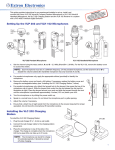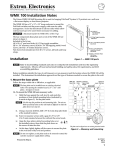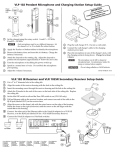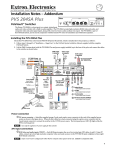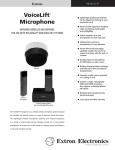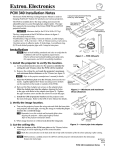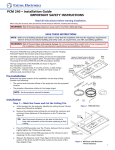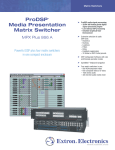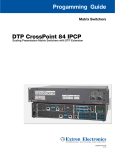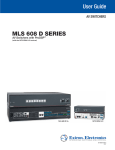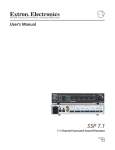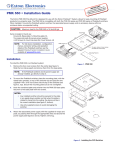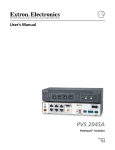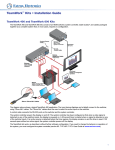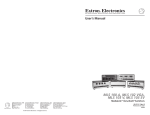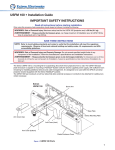Download PVS 305SA User`s Manual
Transcript
PVS 305SA PoleVault® Switcher 68-1576-01 Rev. A 02 10 Precautions Safety Instructions • English Warning This symbol is intended to alert the user of important operating and maintenance (servicing) instructions in the literature provided with the equipment. Power sources • This equipment should be operated only from the power source indicated on the product. This equipment is intended to be used with a main power system with a grounded (neutral) conductor. The third (grounding) pin is a safety feature, do not attempt to bypass or disable it. This symbol is intended to alert the user of the presence of uninsulated dangerous voltage within the product’s enclosure that may present a risk of electric shock. Power disconnection • To remove power from the equipment safely, remove all power cords from the rear of the equipment, or the desktop power module (if detachable), or from the power source receptacle (wall plug). Caution Read Instructions • Read and understand all safety and operating instructions before using the equipment. Retain Instructions • The safety instructions should be kept for future reference. Follow Warnings • Follow all warnings and instructions marked on the equipment or in the user information. Avoid Attachments • Do not use tools or attachments that are not recommended by the equipment manufacturer because they may be hazardous. Consignes de Sécurité • Français Power cord protection • Power cords should be routed so that they are not likely to be stepped on or pinched by items placed upon or against them. Servicing • Refer all servicing to qualified service personnel. There are no user-serviceable parts inside. To prevent the risk of shock, do not attempt to service this equipment yourself because opening or removing covers may expose you to dangerous voltage or other hazards. Slots and openings • If the equipment has slots or holes in the enclosure, these are provided to prevent overheating of sensitive components inside. These openings must never be blocked by other objects. Lithium battery • There is a danger of explosion if battery is incorrectly replaced. Replace it only with the same or equivalent type recommended by the manufacturer. Dispose of used batteries according to the manufacturer’s instructions. Avertissement Ce symbole sert à avertir l’utilisateur que la documentation fournie avec le matériel contient des instructions importantes concernant l’exploitation et la maintenance (réparation). Alimentations• Ne faire fonctionner ce matériel qu’avec la source d’alimentation indiquée sur l’appareil. Ce matériel doit être utilisé avec une alimentation principale comportant un fil de terre (neutre). Le troisième contact (de mise à la terre) constitue un dispositif de sécurité : n’essayez pas de la contourner ni de la désactiver. Ce symbole sert à avertir l’utilisateur de la présence dans le boîtier de l’appareil de tensions dangereuses non isolées posant des risques d’électrocution. Déconnexion de l’alimentation• Pour mettre le matériel hors tension sans danger, déconnectez tous les cordons d’alimentation de l’arrière de l’appareil ou du module d’alimentation de bureau (s’il est amovible) ou encore de la prise secteur. Attention Lire les instructions• Prendre connaissance de toutes les consignes de sécurité et d’exploitation avant d’utiliser le matériel. Conserver les instructions• Ranger les consignes de sécurité afin de pouvoir les consulter à l’avenir. Respecter les avertissements • Observer tous les avertissements et consignes marqués sur le matériel ou présentés dans la documentation utilisateur. Eviter les pièces de fixation • Ne pas utiliser de pièces de fixation ni d’outils non recommandés par le fabricant du matériel car cela risquerait de poser certains dangers. Protection du cordon d’alimentation • Acheminer les cordons d’alimentation de manière à ce que personne ne risque de marcher dessus et à ce qu’ils ne soient pas écrasés ou pincés par des objets. Réparation-maintenance • Faire exécuter toutes les interventions de réparation-maintenance par un technicien qualifié. Aucun des éléments internes ne peut être réparé par l’utilisateur. Afin d’éviter tout danger d’électrocution, l’utilisateur ne doit pas essayer de procéder lui-même à ces opérations car l’ouverture ou le retrait des couvercles risquent de l’exposer à de hautes tensions et autres dangers. Fentes et orifices • Si le boîtier de l’appareil comporte des fentes ou des orifices, ceux-ci servent à empêcher les composants internes sensibles de surchauffer. Ces ouvertures ne doivent jamais être bloquées par des objets. Lithium Batterie • Il a danger d’explosion s’ll y a remplacment incorrect de la batterie. Remplacer uniquement avec une batterie du meme type ou d’un ype equivalent recommande par le constructeur. Mettre au reut les batteries usagees conformement aux instructions du fabricant. Sicherheitsanleitungen • Deutsch Vorsicht Dieses Symbol soll dem Benutzer in der im Lieferumfang enthaltenen Dokumentation besonders wichtige Hinweise zur Bedienung und Wartung (Instandhaltung) geben. Stromquellen • Dieses Gerät sollte nur über die auf dem Produkt angegebene Stromquelle betrieben werden. Dieses Gerät wurde für eine Verwendung mit einer Hauptstromleitung mit einem geerdeten (neutralen) Leiter konzipiert. Der dritte Kontakt ist für einen Erdanschluß, und stellt eine Sicherheitsfunktion dar. Diese sollte nicht umgangen oder außer Betrieb gesetzt werden. Dieses Symbol soll den Benutzer darauf aufmerksam machen, daß im Inneren des Gehäuses dieses Produktes gefährliche Spannungen, die nicht isoliert sind und die einen elektrischen Schock verursachen können, herrschen. Stromunterbrechung • Um das Gerät auf sichere Weise vom Netz zu trennen, sollten Sie alle Netzkabel aus der Rückseite des Gerätes, aus der externen Stomversorgung (falls dies möglich ist) oder aus der Wandsteckdose ziehen. Achtung Lesen der Anleitungen • Bevor Sie das Gerät zum ersten Mal verwenden, sollten Sie alle Sicherheits-und Bedienungsanleitungen genau durchlesen und verstehen. Aufbewahren der Anleitungen • Die Hinweise zur elektrischen Sicherheit des Produktes sollten Sie aufbewahren, damit Sie im Bedarfsfall darauf zurückgreifen können. Befolgen der Warnhinweise • Befolgen Sie alle Warnhinweise und Anleitungen auf dem Gerät oder in der Benutzerdokumentation. Keine Zusatzgeräte • Verwenden Sie keine Werkzeuge oder Zusatzgeräte, die nicht ausdrücklich vom Hersteller empfohlen wurden, da diese eine Gefahrenquelle darstellen können. Instrucciones de seguridad • Español Schutz des Netzkabels • Netzkabel sollten stets so verlegt werden, daß sie nicht im Weg liegen und niemand darauf treten kann oder Objekte darauf- oder unmittelbar dagegengestellt werden können. Wartung • Alle Wartungsmaßnahmen sollten nur von qualifiziertem Servicepersonal durchgeführt werden. Die internen Komponenten des Gerätes sind wartungsfrei. Zur Vermeidung eines elektrischen Schocks versuchen Sie in keinem Fall, dieses Gerät selbst öffnen, da beim Entfernen der Abdeckungen die Gefahr eines elektrischen Schlags und/oder andere Gefahren bestehen. Schlitze und Öffnungen • Wenn das Gerät Schlitze oder Löcher im Gehäuse aufweist, dienen diese zur Vermeidung einer Überhitzung der empfindlichen Teile im Inneren. Diese Öffnungen dürfen niemals von anderen Objekten blockiert werden. Litium-Batterie • Explosionsgefahr, falls die Batterie nicht richtig ersetzt wird. Ersetzen Sie verbrauchte Batterien nur durch den gleichen oder einen vergleichbaren Batterietyp, der auch vom Hersteller empfohlen wird. Entsorgen Sie verbrauchte Batterien bitte gemäß den Herstelleranweisungen. Advertencia Este símbolo se utiliza para advertir al usuario sobre instrucciones importantes de operación y mantenimiento (o cambio de partes) que se desean destacar en el contenido de la documentación suministrada con los equipos. Alimentación eléctrica • Este equipo debe conectarse únicamente a la fuente/tipo de alimentación eléctrica indicada en el mismo. La alimentación eléctrica de este equipo debe provenir de un sistema de distribución general con conductor neutro a tierra. La tercera pata (puesta a tierra) es una medida de seguridad, no puentearia ni eliminaria. Este símbolo se utiliza para advertir al usuario sobre la presencia de elementos con voltaje peligroso sin protección aislante, que puedan encontrarse dentro de la caja o alojamiento del producto, y que puedan representar riesgo de electrocución. Desconexión de alimentación eléctrica • Para desconectar con seguridad la acometida de alimentación eléctrica al equipo, desenchufar todos los cables de alimentación en el panel trasero del equipo, o desenchufar el módulo de alimentación (si fuera independiente), o desenchufar el cable del receptáculo de la pared. Precaucion Leer las instrucciones • Leer y analizar todas las instrucciones de operación y seguridad, antes de usar el equipo. Conservar las instrucciones • Conservar las instrucciones de seguridad para futura consulta. Obedecer las advertencias • Todas las advertencias e instrucciones marcadas en el equipo o en la documentación del usuario, deben ser obedecidas. Evitar el uso de accesorios • No usar herramientas o accesorios que no sean especificamente recomendados por el fabricante, ya que podrian implicar riesgos. 安全须知 • 中文 这个符号提示用户该设备用户手册中有重要的操作和维护说明。 这个符号警告用户该设备机壳内有暴露的危险电压,有触电危险。 注意 阅读说明书 • 用户使用该设备前必须阅读并理解所有安全和使用说明。 保存说明书 • 用户应保存安全说明书以备将来使用。 遵守警告 • 用户应遵守产品和用户指南上的所有安全和操作说明。 避免追加 • 不要使用该产品厂商没有推荐的工具或追加设备,以避免危险。 Protección del cables de alimentación • Los cables de alimentación eléctrica se deben instalar en lugares donde no sean pisados ni apretados por objetos que se puedan apoyar sobre ellos. Reparaciones/mantenimiento • Solicitar siempre los servicios técnicos de personal calificado. En el interior no hay partes a las que el usuario deba acceder. Para evitar riesgo de electrocución, no intentar personalmente la reparación/mantenimiento de este equipo, ya que al abrir o extraer las tapas puede quedar expuesto a voltajes peligrosos u otros riesgos. Ranuras y aberturas • Si el equipo posee ranuras o orificios en su caja/alojamiento, es para evitar el sobrecalientamiento de componentes internos sensibles. Estas aberturas nunca se deben obstruir con otros objetos. Batería de litio • Existe riesgo de explosión si esta batería se coloca en la posición incorrecta. Cambiar esta batería únicamente con el mismo tipo (o su equivalente) recomendado por el fabricante. Desachar las baterías usadas siguiendo las instrucciones del fabricante. 警告 电源 • 该设备只能使用产品上标明的电源。 设备必须使用有地线的供电系统供电。 第三条线 (地线)是安全设施,不能不用或跳过 。 拔掉电源 • 为安全地从设备拔掉电源,请拔掉所有设备后或桌面电源的电源线,或任何接到市 电系统的电源线。 电源线保护 • 妥善布线, 避免被踩踏,或重物挤压。 维护 • 所有维修必须由认证的维修人员进行。 设备内部没有用户可以更换的零件。为避免出现 触电危险不要自己试图打开设备盖子维修该设备。 通风孔 • 有些设备机壳上有通风槽或孔,它们是用来防止机内敏感元件过热。 不要用任何东 西挡住通风孔。 锂电池 • 不正确的更换电池会有爆炸的危险。必须使用与厂家推荐的相同或相近型号的电池。 按照生产厂的建议处理废弃电池。 FCC Class B Notice This equipment has been tested and found to comply with the limits for a Class B digital device, pursuant to part 15 of the FCC Rules. These limits are designed to provide reasonable protection against harmful interference in a residential installation. This equipment generates, uses and can radiate radio frequency energy and, if not installed and used in accordance with the instructions, may cause harmful interference to radio communications. However, there is no guarantee that the interference will not occur in a particular installation. If this equipment does cause harmful interference to radio or television reception, which can be determined by turning the equipment off and on, the user is encouraged to try to correct the interference by one or more of the following measures: • Reorient or relocate the receiving antenna. • Increase the separation between the equipment and receiver. • Connect the equipment into an outlet on a circuit different from that to which the receiver is connected. • Consult the dealer or an experienced radio/TV technician for help. N This unit was tested with shielded cables on the peripheral devices. Shielded cables must be used with the unit to ensure compliance. Table of Contents Chapter One • Introduction........................................................................................................ 1-1 About this Manual..................................................................................................................... 1-2 About the PVS 305SA............................................................................................................... 1-2 TP cable advantages.................................................................................................................. 1-2 Features....................................................................................................................................... 1-3 Application Diagram. ............................................................................................................... 1-4 Chapter Two • Installation. ......................................................................................................... 2-1 UL/Safety Requirements......................................................................................................... 2-2 Important safety instructions................................................................................................... 2-2 Mounting the Switcher........................................................................................................... 2-3 Rear Panel Features and Cabling ..................................................................................... 2-6 A/V input connections............................................................................................................... 2-6 A/V output connections............................................................................................................ 2-8 VoiceLift connection (optional)............................................................................................... 2-8 Aux audio input......................................................................................................................... 2-8 Paging sensor connector (optional)........................................................................................ 2-8 DC Volume/Mute Control......................................................................................................... 2-8 Switcher control......................................................................................................................... 2-9 Speaker output........................................................................................................................ 2-11 Line out audio output............................................................................................................. 2-11 Power supply connector. ........................................................................................................ 2-11 Labeling the A/V Inputs. ....................................................................................................... 2-12 Labeling and connecting the A/V input cables. .................................................................. 2-12 Labeling the PVT Decora® face plates................................................................................... 2-13 Final Setup.................................................................................................................................... 2-13 Chapter Three • Operation and Setup............................................................................... 3-1 Front Panel Features and Operation . ............................................................................ 3-2 Front panel operation............................................................................................................... 3-3 Configuration............................................................................................................................. 3-3 Resetting the Switcher............................................................................................................ 3-3 Executive Mode (Front Panel Security Lockout). .................................................... 3-4 Setting Up and Optimizing the Audio. .......................................................................... 3-4 Steps for optimizing the audio................................................................................................ 3-4 Gain control................................................................................................................................ 3-5 Individual channel input sensitivity control........................................................................ 3-5 Front panel input sensitivity adjustment............................................................................ 3-5 Amplifier level control ........................................................................................................ 3-6 PVS 305SA Switcher • Table of Contents i PRELIMINARY Mounting directly onto the plate using screws.................................................................... 2-3 Mounting onto the plate using brackets............................................................................... 2-4 Wall mounting the PoleVault switcher. ................................................................................. 2-5 Table of Contents, cont’d Bass, treble, and loudness control........................................................................................... 3-6 VoiceLift® level adjustment...................................................................................................... 3-6 Paging sensitivity adjustment.................................................................................................. 3-6 Chapter Four • Serial Communication. ............................................................................. 4-1 RS-232 Programmer’s Guide................................................................................................. 4-2 Host-to-PVS communications................................................................................................... 4-2 PVS-initiated messages......................................................................................................... 4-2 Error responses..................................................................................................................... 4-3 Using the command/response tables.................................................................................. 4-3 Symbol definitions................................................................................................................ 4-3 Factory defaults.................................................................................................................... 4-5 Command/response table for SIS™ commands...................................................................... 4-6 Command/response table for SIS commands (continued)................................................... 4-8 Updating Firmware.................................................................................................................. 4-10 PRELIMINARY Chapter Five • Software Configuration. .......................................................................... 5-1 Configuring the Switcher ..................................................................................................... 5-2 Installing the MediaLink® Switcher Configuration program............................................... 5-2 From the DVD....................................................................................................................... 5-2 From the Web site................................................................................................................ 5-2 Installing the Global Configurator.......................................................................................... 5-3 From the DVD....................................................................................................................... 5-3 Appendix A • Reference Information. .............................................................................. A-1 Specifications — PVS 305SA................................................................................................ A-2 Part Numbers, Cables, and Accessories. ...................................................................... A-5 Included parts............................................................................................................................ A-5 Cables. ........................................................................................................................................ A-5 Appendix B • Speaker Configuration.................................................................................B-2 Terminating the speaker cable................................................................................................B-2 Wiring Information....................................................................................................................B-3 Signal cables...............................................................................................................................B-3 Aux audio input cables....................................................................................................... B-3 Line out audio cables................................................................................................................B-3 Switcher control cables.............................................................................................................B-3 Cabling the switcher. ................................................................................................................B-4 All trademarks mentioned in this manual are the properties of their respective owners. ii PVS 305SA Switcher • Table of Contents PVS 305SA 1 Chapter One Introduction About this Manual About the PVS 305SA Application Diagram Introduction About this Manual This manual covers the installation, operation, and configuration of the Extron PVS 305SA PoleVault® Switcher. Throughout the manual, this switcher is interchangeably referred to as the PVS 305SA or PoleVault switcher. About the PVS 305SA The Extron PVS 305SA is a five input, two output, twisted pair, audio and video switcher with a built-in audio amplifier. It is part of the PoleVault System and is used in conjunction with the Extron PVT series of transmitters and Extron speakers. The PVS 305SA accepts high resolution (RGB) video and audio, and composite video and audio signal inputs, and has a dedicated port for connecting the optional VoiceLift® microphone system. The PVS 305SA is comprised of two independent, built in switchers (a 4 x 1 RGB video and audio switcher and a 2 x1 composite video and audio switcher), that allows the PVS 305SA to accept high resolution (RGB) video and audio, and composite video and audio signal inputs. It has a separate audio input that can be switched with the other four inputs. The PVS 305SA is part of the PoleVault System, a specific cost effective system with easy cable installation for transmission of video and audio signals, that is used in conjunction with the Extron series of PoleVault A/V Source Input Wallplates and Extron speakers. As part of the Extron PoleVault system, the PVS 305SA is installed at ceiling level within an Extron Pole Mount Kit, the PMK 550. Alternatively it can be mounted in a WMK 100 wall mount that is installed on a wall close to the projector. The PoleVault switcher receives the video and audio signals sent from PVT Wallplates, which can be located up to 100 feet away. The signals can be sent over Extron Enhanced Skew-Free™ A/V UTP cable, or any CAT 5, 5e, or 6 shielded twisted pair (STP), unsheilded twisted pair (UTP), or foil shielded twisted pair (FTP) cable. The PoleVault switcher can be controlled from either the front panel buttons, an RS-232 control, an IR remote, or a MediaLink controller. The PVS 305SA has a built-in 2-channel power amplifier that outputs up to 25 W at 2, 4, or 8 ohm loads per channel as stereo or dual mono audio. Volume control is made via RS-232 , IR, or an Extron VCM control. Various front panel controls allow the user to adjust the independent input gains, and VoiceLift microphone input level. RS-232 control allows the user to adjust the individual channel gain, limiter on/off settings, loudness on/off settings, and bass and treble adjustments. TP cable advantages Twisted pair cable is smaller, lighter, more flexible, and less expensive than coaxial cable. Termination of TP cable with RJ-45 connectors is simple, quick, and economical. See chapter 2, “Installation”, “A/V input connections” section, for wiring details. N For PoleVault wallplate installation and connection, consult the user’s manual supplied with the wallplates. 1-2 PVS 305SA Switcher • Introduction Features Twisted pair inputs — The PoleVault switcher accepts two independent, high resolution RGB video and audio signals, and two configurable inputs for either composite video or high resolution RGB signals, and audio signals, transmitted on twisted pair cable from a source up to 100 ft away. Video output — The PoleVault switcher can switch between four inputs (either four RGB or two RGB and two composite). VoiceLift input — The PoleVault switcher can mix a mono line level audio input from the VoiceLift microphone system with the audio input from the video/ audio source. Amplified Audio output — The PoleVault switcher allows user selectable stereo or dual mono, 2/4/8 ohm audio outputs through the integrated audio amplifier. Line Out output — The PoleVault switcher allows for the connection of a recording or listening device for audio output. Paging System support — The PoleVault switcher allows for the connecting of a public address paging system sensor which when activated, mutes the PoleVault switcher’s program for the duration of the PA broadcast. Executive Mode — To prevent unauthorized access the PoleVault switcher panel can be locked (executive mode) via the front panel or RS-232. An LED on the front panel indicates executive mode status. Control and configuration — Firmware updates to the PVS 305SA can be made via a front panel config port. The PoleVault switcher can also be configured via RS-232 and controlled via the front panel, RS-232, or wired IR. Other features include: • User selectable switching of input and status indication LED • Rear panel mounted captive screw connector for RS-232, MLC, or IR control • Rear panel mounted captive screw connector for external volume control • Energy efficient design offers Extron exclusive Auto Power Save and Standby modes designed to lower energy usage and reduce costs. PVS 305SA Switcher • Introduction 1-3 Introduction, cont’d Application Diagram Extron FF 120 Flat Field Ceiling Speakers - 1 Pair Extron SPK 18 - 35' Extron Priority Page Sensor (Optional Accessory) Cable From PA System UTP Cable (CAT 5/5E/6) To PoleVault Switcher Ceiling Mounted Paging Speaker Extron PCM 340 Extron VoiceLift ® Receiver Projector Drop Ceiling Mount (Optional Accessory) Extron PVS 305SA Slotted Projector Mount Pole PoleVault® Switcher Extron PMK 550 Easy Installation Pole Mount Kit CON FIG 1 INPU 2 T SELE CTIO 3 N 4 5 INPU AUX T AUD IO AUD PEAK NORMA L SIGNAL IO LEVE POLE PVS L ADJUVAUL MIC ST 305 T SWIT NORMA IFT L SIGNAL SA CHER PEAK VOICEL PAGIN SENS G OR SENS ITIVIT Y Extron UPB 25 Universal Projector Mounting Bracket Assistive Listening System Extron PVT CV D Composite Video & Audio Input Wallplate VID EO L IN AUD IO IN R IR OUT S G AUD IN IO AUD OUTIO COM PUT ER IN MO NIT OR IR OUT OUT S G RS-232 to Switcher Extron PVT RGB D Plus DVD/VCR Combo DI SP LA Y ON OF F VO LU ME VC R 1 DV D 2 Extron PVT RGB D VGA & Audio Input Wallplate RS-232 to Projector FIG 3 4 ML C 10 4 IP PL US Extron MLC 104 IP Plus AU DIO IN CO MP UT ER IN VID EO L IN AUD IO IN R IR OUT S PC PC CON G Extron PVT CV D MediaLink ® Controller Composite Video & Audio Input Wallplate TCP/IP Network R PW VGA & Audio Input Wallplate Ext ON ron CHARGE IR Emitter R PW OFF/MUTE/CHG Computer w/ Podcasting Software Ext Camera OFF/MUTE/CHG ON ron CHARGE n ro xt E Document Camera Extron VoiceLift Microphone and Charging Station (Optional Accessory) Figure 1-1 — PVS 305SA in a typical PoleVault system installation, with optional accessories 1-4 PVS 305SA Switcher • Introduction PVS 305SA 2 Chapter Two Installation UL/Safety Requirements Mounting the Switcher Rear Panel Features and Cabling Speaker Configuration Labeling the A/V Inputs Final Setup Installation UL/Safety Requirements The Underwriters Laboratories (UL) requirements listed below pertain to the safe installation and operation of this switcher. PRELIMINARY Important safety instructions 1. Read these instructions. 2. Keep these instructions. 3. Heed all warnings. 4. Follow all instructions. 5. Do not use this apparatus near water. 6. Clean only with a dry cloth. 7. Do not block any ventilation openings. Install in accordance with the manufacturer’s instructions. 8. Do not install near any heat sources such as radiators, heat registers, stoves, or other apparatus (including amplifiers) that produce heat. 9. Do not defeat the safety purpose of the polarized or grounding type plug. A polarized plug has two blades with one wider than the other. A grounding type plug has two blades and a third grounding prong. The wide blade or the third prong are provided for your safety. If the provided plug does not fit into your outlet, consult an electrician for replacement of the obsolete outlet. 10. Protect the power cord from being walked on or pinched particularly at plugs, convenience receptacles, and the point where they exit from the apparatus. 11. Only use attachments/accessories specified by the manufacturer. 12. Use only with the cart, stand, tripod, bracket, or table specified by the manufacturer or sold with the apparatus. When a cart is used, use caution when moving the cart/apparatus combination to avoid injury from tip-over. 13. Unplug this apparatus during lightning storms or when unused for long periods of time. 14. Refer all servicing to qualified service personnel. Servicing is required when the apparatus has been damaged in any way, such as power-supply cord or plug is damaged, liquid has been spilled or objects have fallen into the apparatus, the apparatus has been exposed to rain or moisture, does not operate normally, or has been dropped. . 2-2 PVS 305SA Switcher • Installation Mounting the Switcher The PVS 305SA switcher and the power supply can be mounted in the Extron PMK 550 (Pole Mount Kit) that is installed above the projector. The low profile of the PMK 550 allows it to be installed in tight spaces. N There are two models of the PMK 550 and each mounts the PoleVault switcher differently; one directly to the plate, the other using mounting brackets. If there is a need to mount the PoleVault switcher on the PMK 550, follow the appropriate method. Mounting directly onto the plate using screws. Remove the cover securing screws and slide the two plastic covers away from the mounting plate (see figure 2-1). Remove retaining screws (4) and slide the covers away. Figure 2-1 — Remove the PMK 550 covers 2. Invert the mounting plate and the PoleVault switcher (so the top is against the plate) and attach the PoleVault switcher to the plate with the two supplied screws (see figure 2-2). 3. Use the supplied hook-and-loop strips to secure the power supply to the plate. Power Supply PoleVault Switcher Figure 2-2 — PVS 305SA and power supply attached to PMK 550 plate PVS 305SA Switcher • Installation 2-3 PRELIMINARY 1. Installation Mounting onto the plate using brackets. N This method allows mounting and removal of the PoleVault switcher without removing the PMK 550 from the pole. 1. Remove the cover securing screws and slide the two plastic covers away from the mounting plate. 2. Install both brackets into the slot (see figure 2-3). Mounting Brackets PRELIMINARY (2) 4-40 x 3/16" Screws CO NF IG 1 IN 2 PU T SE LE CT IO 3 N 4 5 IN AU X AU PU AU T DI O DI O PEA K NO RM SIG AL NA LE VE PV PO LE L AD VAUL S 30 T 5S JU ST SWITC A MI C L PEA HE K VO ICE LIF NO T RM SIG AL NA L PA GIN SE G NS OR R Rotate to install. SE NS ITI VIT Y Use 2 mounting holes on opposite corners. Figure 2-3 — Fit the brackets in the slot and attach the switcher 3. Slide the PoleVault switcher onto the brackets. Secure it in place by its base using the supplied screws. 4. Use the supplied hook-and-loop strips to secure the power supply to the plate. With the switcher and power supply secure on the plate: 2-4 1. Loosen the screws on the pipe collar and slide the plate up the projector pole. 2. Tighten the screws around the collar, ensuring that at least three screws are in contact with the pole. 3. If installing the full PoleVault system, continue installing the rest of the hardware, devices and cabling, referring where applicable to the instructions in the PoleVault System Installation Manual (online at www.extron.com). 4. Connect the twisted pair, audio, control, and power cables (see “Rear Panel Features and Cabling” in this chapter for details). 5. Replace the covers of the PMK 550. PVS 305SA Switcher • Installation Wall mounting the PoleVault switcher 1. Following the instructions supplied with the WMK 100, prepare the wall and temporarily mount the base plate on the wall at the desired location. 2. Run the signal cables from the PoleVault input wallplates, control device, and the speakers to the WMK 100 location. Cables can be routed behind the walls, or through a surface raceway. 3. Remove the WMK 100 base plate from the wall, and with the switcher’s rear ports facing the cable access hole, align the two corner holes in the base of the switcher with the two outermost device mounting holes in the WMK 100 base plate. Secure with the supplied 440 x ¼ inch screws. 4. Use the supplied hook-and-loop straps to attach the power supply above the electrical outlet cutout. Rout the cables to the electrical outlet and switcher. 5. Re-attach the plate to the wall and secure firmly. 6. Connect the cables from the PoleVault transmitters, control device (MediaLink Controller), speakers, and optional accessories (VoiceLift, Page Sensor Kit) to the rear ports of the switcher. 7. Run VGA and composite video ouput cables from the switcher to the output display device through the wall or, where fitted, the raceway. 8. Connect the power supply to the switcher and plug it in to the outlet. N If the electrical outlet is outside the WMK, pass the IEC power cable out through one of the raceway knockouts. 9. After completion of cabling, place the cover over the installed plate, and secure at each corner with the provided 6-32 button head screws. N Ensure any cables exiting the box (e.g., to display device and external electrical outlet) pass through a raceway knockout. SENSITIVITY SIGNAL PAGING SENSOR NORMAL PVS 305SA PEAK MIC VOICELIFT SIGNAL AUDIO LEVEL ADJUST NORMAL PEAK 3 CONFIG 1 2 INPUT SELECTION 4 5 AUX AUDIO INPUT POLEVAULT SWITCHER Figure 2-4 — Cable the device and attach the cover 10. Switch on the display device, control device, signal sources and adjust and configure the system as needed. For full PoleVault System configuration and setup details, refer to the PoleVault System Installation Manual, or the MLC 104 Plus Series Reference Manual, both available online at www.extron.com. PVS 305SA Switcher • Installation 2-5 PRELIMINARY Using the Extron WMK 100 Wall Mounting Kit, the PoleVault switcher can be mounted on a wall near a flat screen display or short throw projector. Installation Rear Panel Features and Cabling 1 PVT RGB D PVT RGB D Plus Inputs (1-4, A and B) N15779 1ARGB RGB 1A 2A 2ARGB RGB 3A 3A RGB RGB 5 4A 4ARGB RGB ® POWER 12V 5A MAX OUTPUTS VIDEO RGB 1BRGB RGB 1B Power Supply Connector 12 US LISTED I N P U T S 2B 2B RGB RGB LINE OUT 17TT AUDIO/VIDEO APPARATUS VOICELIFT RECEIVER L R L R RGB RGB 4B 4BRGB RGB 3B3BVIDEO VIDEO /VIDEO 10 11 Lineout Speaker VoiceLift Receiver Port Output Output AUX AUDIO INPUT 5 /VIDEO PVT CV D Inputs RGB Output 2 (3 and 4) 4 10V 50mA CONTROL Tx Rx IR 12V PAGING RS-232 MLC/IR SENSOR VOL/MUTE Aux Audio Video Output 3 AMPLIFIED AUDIO OUT DO NOT GROUND OR SHORT 2/4/8 SPEAKER Ohms OUTPUTS L R CLASS 2 WIRING 6 Input Paging Sensor 7 Port MLC Control Port 9 Volume/Mute Control Port 8 PRELIMINARY Figure 2-5 — Features of the PVS 305SA rear panel A/V input connections a RGB video and audio inputs (“RGB”) — Each RGB input (inputs 1 to 4) requires the use of two twisted pair (TP) cables, A and B. Using TP cables, connect up to four high resolution computer video and audio sources via PVT wallplates to these eight RJ-45 female connectors. Inputs 3 and 4 need to be set via software to accept RGB signals (default is composite video). The PoleVault signal transmission method is specific for PVS 305SA switchers working with PVT wallplates. DO NOT connect to an MTP system. DO NOT connect to an Ethernet/LAN or data transmission system. N The PVS 305SA is capable of receiving signals from PVT wallplates located up to 100 feet (30m) away. The optimum distance is between 50 and 75 feet (15 and 22 meters). Minimum distance is 15 feet (4.6 meters). The RGB cables supplied with the PoleVault system are terminated to the TIA/EIA T568A standard. If other cables are used the RJ-45 termination must comply with the T568A or T568B wiring standards (as shown in figure 2-6), and the same standard MUST be used at both ends of the cables. C Pins: 12345678 Pin Insert Twisted Pair Wires RJ-45 Connector T568A Wire color T568B Wire color 1 White-green White-orange 2 Green Orange 3 White-orange White-green 4 Blue Blue 5 White-blue White-blue 6 Orange Green 7 White-brown White-brown 8 Brown Brown NOTE If you are using Enhanced Skew-Free™ A/V cable, use the TIA/EIA T568A standard only. Figure 2-6 — Twisted pair RGB video and audio cable wiring The ports on the rear of the PVS 305SA are color coded for input number and signal type. To ensure correct cable identification and connection during installation, a sheet of color coded cable labels is supplied. See “Labeling the A/V Inputs”, later in this chapter, for details on how to use these labels. 2-6 PVS 305SA Switcher • Installation When connecting the TP cables to the PVS 305SA, take care not to cross-connect the cables; connect input cable 1A to the RJ-45 port labeled 1A, and input cable 1B to the RJ-45 port labeled 1B. Likewise, connect input cables 2A, 3A, or 4A to its corresponding numbered A port, and cable B to its B port (see figure 2-7). PVT RGB D Input #1 PVT RGB D Input #2 N15779 Cable from PVT Output A Cable from PVT Output B RGB A RGB B OUT OUT 1A POWER RGB 2A I N P U T S Cable from PVT Output B 1B 12V 5A MAX Cable from PVT Output A RGB A RGB B OUT OUT 2B RGB Input Connectors on Rear Panel of PVS 305SA Rear Panel Rear Panel Figure 2-7 — Connect RGB wallplate output cables to the switcher RGB inputs. b Composite video and audio inputs (”Video”) — Each composite video input needs one TP cable. Using TP cable, connect up to two composite video and audio sources via PVT wallplates to these two RJ-45 female connectors labeled 3 and 4; each one is for video and audio combined. N These ports can also be configured via RS-232 for RGB video input. Default is for composite video. 3A RGB 3B RGB VIDEO 4A RGB 4B RGB VIDEO When connecting the TP cables to the switcher, take care to connect input 3’s cable to the RJ-45 port labeled 3, and input 4’s cable to the RJ-45 port labeled 4 (see figure 2-8). Though these ports can also be used for RGB signals, do not connect an RGB cable (cable A) to the top ports when connecting composite video inputs to the lower ports. See the note on page 2-6 about cables and cable termination. PVT CV D Input #4 PVT CV D Input #3 3A RGB 4A RGB Composite Video Cable from PVT Output 3B Rear Panel RGB VIDEO 4B RGB VIDEO Composite Video Input Connectors on Rear Panel of PVS 305SA Rear Panel Figure 2-8 — Connect the composite video wallplate output cables to the switcher video inputs. PVS 305SA Switcher • Installation 2-7 Installation, cont’d A/V output connections c d RGB video output — Connect a VGA cable to this female 15-pin HD connector and to the projector RGB input. Composite (video) output — Connect an RCA cable to this female RCA jack and to the projector composite input. VoiceLift connection (optional) e VoiceLift receiver connector — Connect an optional Extron VoiceLift IR receiver to this RJ-45 connector for integration of a VoiceLift Microphone system. N The Extron VoiceLift Microphone is an optional accessory which must be purchased separately. To install the VoiceLift Microphone system, refer to the “VoiceLift Installation Guide”, supplied with the device. Aux audio input PRELIMINARY f Aux audio input — Input 5 is a dedicated audio only input for an auxiliary, stereo, line-level audio signal from an audio output source such as audio from a DVI/HDMI device or an MP3 player. Connect a cable from the source to this 5‑pole captive screw connector. It can be wired as balanced or unbalanced. See appendix B for wiring details. Paging sensor connection (optional) g Paging system sensor input — Connect the optional Extron Priority Page Sensor to this port to enable audio interrupts during paging system use. N Enable the switcher’s paging sensor port, using Global Configurator or the MediaLink® Switchers (MLS) and PoleVault Switchers (PVS) control software, available at www.extron.com. The Extron Priority Page Sensor Kit (part #70-619-01) is an optional accessory which must be purchased separately. DC Volume/Mute Control h DC Volume control port (Vol/Mute) — This port is used to connect an Extron external volume control module, such as a VCM 100 to the PVS 305SA. The range is 0 to 10 V, where 0 V is mute and 10 V is maximum volume. When connected, the external volume control module is the sole volume controller. N Do not control the PVS volume via RS-232 if this port is connected to a VCM 100. If a VCM 100 is controlling the volume, an MediaLink Controller (MLC) should not be connected to the MLC/IR/RS-232 port. Connect the supplied blue, male, 3‑pole captive screw connector to this port, wiring the connector as shown in figure 2-9. VOLUME MUTE VCM 100 MAAP DC VOL 10 V VOL/MUTE VOL/ MUTE 10V VCM 100 MAAP front and rear panels PVS 305SA DC Volume port 10 V Variable voltage or mute Ground Figure 2-9 — Wiring a VCM 100 MAAP to the DC volume port 2-8 PVS 305SA Switcher • Installation Switcher control i Control port — The PVS switcher can be controlled via an RS‑232 connection directly from a host computer, a control system, or a MediaLink Controller. For IR remote control connect an Extron IR Link to this port. RS-232 connection can be used to configure the PVS switcher. Connect a cable between this port and an Extron MediaLink Controller or an optional IR Link IR signal repeater. • The MLC provides remote control of input switching and volume. • The IR Link accepts modulated IR signals from a remote control (for The RS-232 protocol is • 9600 baud • 8-bit • 1 stop bit • no parity • no flow control. Refer to the MLC 104 IP Plus Series Reference Manual for full details. example, the Extron IR 452 remote) enabling the remote control to be used for selecting the switcher inputs. Wire the captive screw connector and connect it to a computer or control system, an MLC, or an IR Link, as shown in figures 2-10 through 2-12. CONTROL Tx Rx IR +12V A BC DE N15779 1A RGB 2A RGB 3A RGB 4A RGB ® PVS 305SA Switcher's rear panel Control port LISTED I N P U T S POWER OUTPUTS 1B RGB 12V 5A MAX VIDEO RGB 2B RGB US AMPLIFIED AUDIO OUT DO NOT GROUND OR SHORT 2/4/8 SPEAKER Ohms OUTPUTS L R CLASS 2 WIRING LINE OUT 17TT AUDIO/VIDEO APPARATUS VOICELIFT RECEIVER RGB RGB 3B VIDEO 4B VIDEO L R L R 10V 50mA CONTROL Tx Rx IR 12V PAGING RS-232 MLC/IR SENSOR VOL/MUTE AUX AUDIO INPUT 5 PVS 305SA Rear Panel Projector RS-232 +12 VDC input NOTE If you use cable that has a drain wire, tie the drain wire to ground at both ends. RS-232 and power DISPLAY ON B Receive (Rx) Transmit (Tx) B A Transmit (Tx) Receive (Rx) A VCR OFF DVD VOLUME PC 1 2 LAN Ground ( ) PRESS TAB WITH TWEEKER TO REMOVE 3 CONFIG Tx A B +12V IN Rx 3 GROUND 2 DIGITAL I/O GROUND 1 GROUND CM SCP IR IN GROUND Rx +V OUT A B C D E COMM LINK MLS PWR RS-232 12V +12V IN Tx MLS GROUND A B MLC 104 IP Plus MLS and power ports DISPLAY RS-232/IR MLC 104 IP Plus front and side panels Rx You must connect a ground wire between the MLC and the switcher. GROUND NOTE MLC 104 IP PLUS IR OUT Tx 50 feet (38 m) maximum GROUND 4 PWR RS-232 12V Figure 2-10 — Connecting an MLC 104 to the switcher N The PVS 305SA power supply can support a typical system, for example: • a PVS 305SA • 4 PVT Wallplates • 2 or 4 speakers (see “Speaker Configuration” in appendix B for details) • an MLC 104 IP Plus with an IRCM DV+ • VoiceLift microphone system • If an SCP 104 is used in the system, the MLC 104 Plus MUST have its own power supply. • The PVS 305SA provides sufficient power to run an MLC 104 IP Plus or MLC 226 IP model. PVS 305SA Switcher • Installation 2-9 Installation, cont’d N15779 1A RGB CONTROL Tx Rx IR +12V ABC DE 2A RGB 3A RGB 4A RGB ® POWER PVS 305SA Switcher rear panel Control port VOICELIFT RECEIVER OUTPUTS VIDEO RGB 1B RGB 12V 5A MAX 2B RGB LINE OUT 17TT AUDIO/VIDEO APPARATUS US LISTED I N P U T S RGB RGB 3B VIDEO 4B VIDEO L R L R AMPLIFIED AUDIO OUT DO NOT GROUND OR SHORT 2/4/8 SPEAKER Ohms OUTPUTS L R CLASS 2 WIRING AUX AUDIO INPUT 5 10V 50mA CONTROL Tx Rx IR 12V PAGING RS-232 MLC/IR SENSOR VOL/MUTE PVS 305SA Rear Panel NOTE If you use cable that has a drain wire, tie the drain wire to ground at both ends. or Ground ( ) NOTE B Receive (Rx) Transmit (Tx) 3 A Transmit (Tx) Receive (Rx) 2 Host Computer Connect a ground wire between the switcher and the computer or control system. RS-232 port of a computer or control system Control System PRELIMINARY Figure 2-11 — Connecting a computer or control system N15779 1A RGB 2A RGB 3A RGB 4A RGB US ® POWER LISTED I N P U T S OUTPUTS RGB 1B RGB 12V 5A MAX 2B RGB VIDEO LINE OUT 17TT AUDIO/VIDEO APPARATUS VOICELIFT RECEIVER RGB RGB 3B VIDEO 4B VIDEO L R L R AUX AUDIO INPUT 5 AMPLIFIED AUDIO OUT DO NOT GROUND OR SHORT 2/4/8 SPEAKER Ohms OUTPUTS L R CLASS 2 WIRING 10V 50mA CONTROL Tx Rx IR 12V PAGING RS-232 MLC/IR SENSOR VOL/MUTE PVS 305SA Rear Panel CONTROL Tx Rx IR +12V A B C D E A BCD E PVS 305SA Switcher rear panel Control port IR Link port IR C IR (IR Link) D 150 feet (45.7 m) maximum DVD +12 VDC Ground ( ) SIGNAL IR 452 IR Link front and rear panels Figure 2-12 — Connecting an IR Link to the switcher 2-10 PVS 305SA Switcher • Installation Speaker output j Amplified audio out — Connect one speaker to each channel marked “L” and “R” (left and right) using the supplied black 4-pin 5 mm connector. Wire the red cable to positive and the black cable to negative. Each channel is rated for 25 W at 2, 4, or 8 ohm loads. AMPLIFIED OUTPUTS 2/4/8 Ohms L R If using more than one speaker per channel, connect them in parallel. Refer to appendix B, “Speaker Configuration” section, for details on speaker configuration. C Do not tie both L and R outputs to each other and/or to ground as it may short the outputs and damage the amplifier. N The speaker setup covers two individual speakers of 8 ohm impedance or two pairs of speakers in parallel, where each channel drives a maximum output load of 2 ohms. Line out audio output k LINE OUT Line out audio port — This port is used for connecting an Extron external amplifier, recording, podcasting, or assisted listening L R devices. It can be configured via RS-232 for fixed or variable audio output (default is variable). It can be wired for balanced or unbalanced signals. See appendix B for wiring details. Power supply connector l DC power connector — When all other cables have been connected, plug the round power jack from the 12 VDC power source into this connector to power the switcher, the PVT wallplates, the MediaLink controller and, where installed, the VoiceLift receiver. One of the five front panel input button LED is lit when the PVS 305SA is receiving power. N Use only the supplied 12 V, 5 A power supply for this switcher. The PVS 305SA power supply can support a typical system: for example, a PVS 305SA, 4 PVT Wallplates, 2 or 4 speakers, an MLC 104 IP Plus with an IRCM DV+, and a VoiceLift Microphone system. If an SCP 104 is used in the system, the MLC 104 IP Plus MUST have its own power supply. PVS 305SA Switcher • Installation 2-11 Installation, cont’d Labeling the A/V Inputs Labeling and connecting the A/V input cables The RGB and composite video input ports on the rear of the PVS 305SA are color coded to aid easy identification of the input signal type. A sheet of corresponding colored labels is supplied for the installer to label the cables running from the PVT Wallplates to the switcher. Once the labels are attached to the cables, the signal type transmitted on any cable can clearly be identified, enabling correct cable connection during installation. To label the cables, 1. Peel off the label corresponding to the cable’s signal type (see the table below) and affix it close to one end of the cable. N Align and press the colored section of the label to the cable first, then wrap the clear section around the cable, allowing the signal type name to be easily read. PRELIMINARY RGB #1A Figure 2-12 — Wrap the label around the cable, colored part first. 2. Repeat step 1 for the other end of the cable, using the same label type. 3. Using the correct label type, repeat steps 1 and 2 as necessary for all signal cables that are to be connected to the PVS 305SA. 4. Connect the colored coded cable to the corresponding color coded port (see table below). RGB #1A N15779 1ARGB RGB 1A 2A 2ARGB RGB 3A 3A RGB RGB 4A 4ARGB RGB ® POWER 12V 5A MAX LISTED I N P U T S OUTPUTS RGB 1BRGB RGB 1B 2B 2B RGB RGB RGB RGB 3B3BVIDEO /VIDEO VIDEO US LINE OUT 17TT AUDIO/VIDEO APPARATUS VOICELIFT RECEIVER RGB RGB 4B4BVIDEO /VIDEO L R L R AMPLIFIED AUDIO OUT DO NOT GROUND OR SHORT 2/4/8 SPEAKER Ohms OUTPUTS L R CLASS 2 WIRING AUX AUDIO INPUT 5 RGB #1B 10V 50mA CONTROL Tx Rx IR 12V PAGING RS-232 MLC/IR SENSOR VOL/MUTE VIDEO #4 Figure 2-13 — Connect the cables to the relevant input port. 2-12 Cable Input Signal Input Port # Background Color Text color RGB (cable A) 1A Orange Black RGB (cable B) 1B Orange Black RGB (cable A) 2A Yellow Black RGB (cable B) 2B Yellow Black RGB (cable A) 3A Magenta White RGB (cable B) 3B Magenta White RGB (cable A) 4A Pale Green Black RGB (cable B) 4B Pale Green Black Video 3B Green White Video 4B Red White PVS 305SA Switcher • Installation Labeling the PVT Decora face plates To help identify the input number and type of signal that RGB IN #1 any PVT Decora wallplate sends to the PVS switcher when the wallplate is installed, a series of small labels are supplied. A label identifying the transmitted signal type should be affixed to each Decora face plate (top or bottom) where it can easily be seen after installation. This aids the user to connect a device corresponding to the plate transmission signal type, allowing correct input switching at the PVS 305SA. Final Setup With an MLC 104 IP Plus as a standard MLC controller in the PoleVault system package, your final PVS 305SA switcher setup should look similar to the figure below. Ensure all connections are correctly made and secure. N Refer to the PoleVault Installation Guide and MLC 104 Plus Series Setup Guide for full MLC installation, configuration, and operating details. DVD Player Laptop PC VIDEO IN AUDIO IN AUDIO IN L R COMPUTER IN IR OUT S G PVT RGB D N15779 1ARGB RGB 1A PVT CV D 2A 2ARGB RGB 3A 3A RGB RGB 4A 4ARGB RGB POWER PVT RGB D US ® AUDIO IN COMPUTER IN 12V 5A MAX LISTED I N P U T S OUTPUTS VIDEO RGB 1BRGB RGB 1B 2B 2B RGB RGB LINE OUT 17TT AUDIO/VIDEO APPARATUS VOICELIFT RECEIVER RGB RGB 4B 4BRGB RGB 3B3BVIDEO VIDEO /VIDEO L R L R AUX AUDIO INPUT 5 /VIDEO AMPLIFIED AUDIO OUT DO NOT GROUND OR SHORT 2/4/8 SPEAKER Ohms OUTPUTS L R CLASS 2 WIRING 10V 50mA CONTROL Tx Rx IR 12V PAGING RS-232 MLC/IR SENSOR VOL/MUTE FF 120 Speakers RS-232 RS-232 Tx A B +12V IN E Rx B SCP COMM GROUND G A GROUND +V LAN PROJECTOR RS-232/IR SCP PWR SNS GROUND GROUND Rx Rx Tx Tx/IR GROUND HOST/ CONFIG PRESS TAB WITH TWEEKER TO REMOVE +12V OUT Projector MLS PWR RS-232 12V MLC 104 IP Plus Figure 2-14 — MLC 104 IP Plus controller and other typical devices connected to the PVS switcher. PVS 305SA Switcher • Installation 2-13 PVS 305SA 3 Chapter Three Operation and Setup Front Panel Features and Operation Setting Switcher Modes Auto Switching Setting Up and Optimizing the Audio Resetting the Switcher Executive Mode (Front Panel Security Lockout) Operation and Setup Front Panel Features and Operation PVS 305SA INPUT SELECTION POLEVAULT SWITCHER 1 2 3 AUDIO LEVEL ADJUST 5 4 INPUT PEAK MIC CONFIG SIGNAL AUX AUDIO 2 1 3 4 PAGING SENSOR PEAK NORMAL NORMAL VOICELIFT SIGNAL SENSITIVITY 5 6 Figure 3-1 — Front panel features a Configuration port — This 2.5 mm port (jack) can be used to configure the PVS 305SA during setup via RS-232. Use the optional 2.5 mm configuration cable, part # 70-335-01 (see figure 3-2), for connection to your PC’s serial port. PRELIMINARY 6 feet 1 5 6 9 Tip Ring 9-pin D Connection TRS Plug Pin 2 Pin 3 Pin 5 Computer's RX line Computer's TX line Computer's signal ground Tip Ring Sleeve Sleeve (Gnd) Figure 3-2 — Front 2.5 mm port configuration cable (part # 70-335-01) N Extron recommends using this port to upload firmware where necessary. b c d Video input selection buttons and indicator LEDs — Press one of these buttons to select the desired audio and video input. The corresponding green LED lights and remains lit while the input is selected. These buttons are also used to configure the switcher. Aux audio input button and LED — Input 5 is a dedicated audio only input for an auxiliary, stereo, line-level audio signal from an audio output source such as a DVI/HDMI device or an MP3 player. The green LED lights and remains lit while the input is selected. Input audio adjustment knob and LEDs — Use this knob to adjust the input levels through 43 positions in 1 dB steps (-18 to +24 dB, default 0). The LEDs indicate level set (see page 3-5 for details). e VoiceLift MIC adjustment knob and LEDs — Use this knob to adjust the microphone levels through 43 positions in 1 dB steps (-18 to +24 dB, default 0). The LEDs indicate level set (see page 3-6 for details). This input is not affected by volume adjustment, bass, treble and loudness control via RS-232 or MediaLink® control. f 3-2 Page Sensitivity adjustment knob — Use this knob to make adjustments to the sensitivity of the paging system, where installed (see page 3-6 for details). PVS 305SA Switcher • Operation and Setup Front panel operation N See the front panel image (figure 3-1) for the location of input buttons, adjustment knobs, LEDs, and configuration port. • To change inputs, select an input button, 1 through 4 (video and audio), or 5 (audio only). • To adjust audio input levels, rotate the Input adjustment knob through 43 positions in 1 dB steps (-18 to +24 dB, default 0). • To adjust VoiceLift microphone levels, rotate the MIC adjustment knob through 43 positions in 1dB steps (-18 to +24 dB, default 0). N Front panel LEDs indicate input and mic levels (see image at right). On initial switcher power-up the amplifier level is automatically adjusted to 50%. • To adjust paging sensitivity, rotate the Paging knob clockwise to increase and counter-clockwise to decrease sensitivity. PEAK Level set too high, lower input gain. Level has been NORMAL properly adjusted. SIGNAL Signal threshold; raise input gain. The PVS 305SA switcher can be controlled by a MediaLink Controller (MLC) or by an RS-232 device acting through the MLC. Alternatively, the switcher can be set up and controlled via a host computer or other device (such as a control system) attached to the switcher’s rear panel RS-232/MLC/IR port. The control device (host) can use either the Extron Simple Instruction Set (SIS™) commands, the Global Configurator (GC) program for Windows, or the MediaLink Switchers (MLS) and PoleVault Switchers (PVS) control software, available at www.extron.com. Firmware updates can be made via the front panel configuration port before installation (connect a 2.5 mm configuration cable, part # 70-335-01, to the serial port on the front panel). After installation they can be made through a IP link via the MediaLink Controller connected to the PVS 305SA’s rear RS-232 port. N Refer to chapter 4 for a full list of the relevant SIS commands. Inputs 3 and 4 can be configured for signal type (RGB or composite video) via RS-232 and SIS commands. The default is composite video. Resetting the Switcher The switcher can be reset to the factory defaults via the front panel or RS-232. To reset the switcher via the front panel, follow these steps. 1. Unplug the switcher from the power source. 2. Press and hold input selection button 1 while reapplying power to the switcher. All input selection LEDs blink for 1 second during switcher reset. For details on RS-232 control, see chapter 4, “Serial Communication”. PVS 305SA Switcher • Operation and Setup 3-3 PRELIMINARY Configuration Operation and Setup, cont’d Executive Mode (Front Panel Security Lockout) To prevent accidental or unauthorized changes to settings, the PVS switcher has a front panel security lockout (executive mode) that limits users’ access to front panel controls. When the executive mode is active, all functions are locked. To turn executive mode on or off via the front panel: 1. Press and hold input selection buttons 1 and 4 simultaneously for 4 seconds (see figure 3-2). All the input LEDs light. 2. Release the buttons. The LEDs extinguish except for the currently selected input. The switcher has enabled or disabled the executive mode. INPUT SELECTION 1 2 3 INPUT SELECTION 4 5 1 2 3 4 5 AUX AUDIO Press and hold buttons 1 and 4 simultaneously for 4 seconds. All input LEDs light. to indicate that Release the buttons. The LEDs extinguish except for the currently selected input. Executive mode has been enabled/disabled. Figure 3-3 — Setting the executive mode via the front panel PRELIMINARY This mode can also be turned on or off through RS-232 control. For details on RS-232 control, see chapter 4, “Serial Communication”. Setting Up and Optimizing the Audio The following steps ensure optimal sound is achieved by configuring the switcher. For each step, refer to the sections indicated for more information. Steps for optimizing the audio 1. Ensure all the settings are at default. These are the settings the PVS has upon initial power up. The default settings are as shown below. • • • • N Volume is set at 50%. Bass and treble are set at 0. Amplifier level is set to 50%. Loudness control is set to Off. Amplifier level and volume level are not the same adjustments. Volume can only be adjusted by RS-232 or with a potentiometer connected to the rear panel port labeled “DC Vol”. Amplifier level can only be adjusted via RS-232 or control software. 2. Ensure that the PVT transmitters are connected to the PVS and that there is an audio input source present at each of the transmitters. Refer to the transmitters’ user’s manual for installation/connection information. 3. Ensure a set of speakers are connected to the PVS 305SA. See appendix B, “Speaker Configuration” section, for details. 4. Slowly adjust the volume to 100% via RS-232, by having the MLC increase the volume, or by a potentiometer connected to the DC Volume port on the rear panel. If an MLC 104 IP Plus is connected to the PVS, simply rotate the volume knob clockwise until it is at full volume. 5. Adjust the input sensitivity for one input through the front panel or by RS-232 control software to a level just below where audio input is peaking. See the sections “Individual channel input sensitivity control” and “Front panel input sensitivity control”, later in this chapter, for details. Repeat for all five inputs. N Adjusting input sensitivity for all inputs ensures that all inputs are at the same level, and at the highest level possible before peaking occurs. Step 5 ensures that when the volume is at 100% the audio signal will not be distorted (clipped). 3-4 PVS 305SA Switcher • Operation and Setup When adjustments to all five inputs’ sensitivity settings have been made, then adjust the amplifier level (via RS-232 only). Increase or decrease the amplifier level very slowly, if needed. N If the volume is at 100% through the MLC and the output on the speakers is too loud, reducing the amp level via RS-232 control software is recommended. This ensures that the volume will not be too loud, even when set at 100%. 7. Fine tune the audio by making adjustments to the bass, treble, and loudness until the desired settings are reached. See “Bass, treble, and loudness control” later in this chapter. 6. Gain control Individual channel input gain control adjustments are made by rotating the adjustment knob for the selected input button. The adjustment range is -18 dB to +24 dB, with the default set at 0 dB. N Adjusting input sensitivity for all inputs ensures that all inputs are at the same level and at the highest level possible before clipping occurs. Individual channel input gain levels either adds to or subtracts from the overall (global) power amplifier gain level per channel. Front panel input sensitivity adjustment N Upon initial power up of the switcher, the amplifier level is automatically adjusted to 50%. To make sure the right input sensitivity is attained, do the following: 1. For the active input (with the LED lit), rotate the level adjustment knob until the Normal LED blinks. N Having the audio level beyond the point at which the peak LED flashes results in a distorted output signal (clipping). AUDIO LEVEL ADJUST INPUT PEAK MIC NORMAL SIGNAL PEAK PAGING SENSOR SIGNAL Level has been NORMAL properly adjusted. NORMAL VOICELIFT PEAK Level set too high, lower input gain. SENSITIVITY SIGNAL Signal threshold; raise input gain. Figure 3-4 — Front panel Input audio Min/Max LED and adjustment knobs Individual gain adjustment can also be made by RS-232 control software as shown in chapter 4, “Serial Communication”. 4. Repeat steps 1 through 3 for the other inputs as desired. PVS 305SA Switcher • Operation and Setup 3-5 PRELIMINARY Individual channel input sensitivity control Operation and Setup, cont’d Amplifier level control Amplifier level control is adjusted via RS-232 or control software only. See chapter 4, “Serial Communication”, for details on RS-232 control. Bass, treble, and loudness control For optimum audio quality, the audio input levels and the bass, treble, and loudness controls must all be set up properly. Input audio levels may need to be adjusted depending on the variation of the output levels from different source devices. N By default these levels are set for the consumer product level of ‑10 dBV. Bass and treble should be adjusted once the input and output levels have been adjusted. These are adjusted by RS-232 control only, with a range from -10 dB to +10 dB. By default the bass and treble have been set at 0 dB. See chapter 4, “Serial Communication”, for details on RS-232 control. The loudness on/off (default off) switch function is also controlled by RS-232. VoiceLift level adjustment PRELIMINARY To adjust VoiceLift microphone levels, rotate the MIC adjustment knob through 43 positions (in 1 dB steps) from -18 dB to +24 dB, default is 0 dB. AUDIO LEVEL ADJUST INPUT PEAK MIC NORMAL SIGNAL PEAK PAGING SENSOR SIGNAL Level has been NORMAL properly adjusted. NORMAL VOICELIFT PEAK Level set too high, lower input gain. SENSITIVITY SIGNAL Signal threshold; raise input gain. Figure 3-5 — Front panel VoiceLift Mic Min/Max LED and adjustment knob Paging sensitivity adjustment To adjust Paging sensitivity, rotate the Paging Sensor adjustment knob clockwise to increase sensitivity and counter-clockwise to decrease sensitivity. AUDIO LEVEL ADJUST INPUT PEAK MIC NORMAL SIGNAL PEAK PAGING SENSOR SIGNAL Level has been NORMAL properly adjusted. NORMAL VOICELIFT PEAK Level set too high, lower input gain. SENSITIVITY SIGNAL Signal threshold; raise input gain. Figure 3-6 — Front panel Paging Sensor Min/Max LED and adjustment knob Paging sensor delay (0-8, in 1 second steps) can be set via RS-232 or control software. The default = 0 (disabled). N The Paging Sensor port must be enabled in order to work. 3-6 PVS 305SA Switcher • Operation and Setup PVS 305SA 4 Chapter Four Serial Communication RS-232 Programmer’s Guide Updating Firmware Serial Communication The PVS 305SA switcher can be remotely set up and controlled via a host computer or other device (such as a control system) attached to the rear panel Control port. Alternatively, the switcher can be controlled by an MediaLink Controller (MLC) (connected to the same port) or by an RS-232 device acting through the MLC. The control device (host) can use either the Extron Simple CONTROL Instruction Set (SIS™) commands or the Global Configurator Tx Rx IR +12V program for Windows. For details on use and setup of A B C D E a system that includes a MLC, refer to the MediaLink Controller user’s manual. Switcher protocol: • 9600 baud • 1 stop bit • no parity • no flow control (A) Transmit (Tx) (B) Receive (Rx) (C) IR in (D) Ground ( ) (E) +12 VDC out Control connector pin assignments: N Configuration can also be completed by connecting a 2.5 mm stereo mini cable (part # 70-335-01) to the 2.5 mm jack (port) on the front panel. This port has the same protocol as the RS-232 connector on the rear panel. 1 5 6 9 Tip Ring 9-pin D Connection TRS Plug Pin 2 Pin 3 Pin 5 Computer's RX line Computer's TX line Computer's signal ground Tip Ring Sleeve Sleeve (Gnd) Figure 3-1 — Pinout diagram for 2.5 mm mini cable TRS plug when connecting to the front panel Config port N Firmware updates can be made only via the front panel Config port. RS-232 Programmer’s Guide Host-to-PVS communications SIS commands consist of one or more characters per field. No special characters are required to begin or end a command sequence. When the PVS switcher determines that a command is valid, it executes the command and sends a response to the host device. All responses from the switcher to the host end with a carriage return and a line feed (CR/LF = ]), which signals the end of the response character string. A string is one or more characters. PVS-initiated messages When a local event such as a front panel selection or adjustment takes place, the PVS responds by sending a message to the host. No response is required from the host. The PVS-initiated messages are listed here (underlined). © Copyright 2009, Extron Electronics, PVS 305SA, V1.xx The PVS sends the copyright message when it first powers on. V1.xx is the firmware version number. 4-2 PVS 305SA • Serial Communication PRELIMINARY PRELIMINARY 6 feet Error responses When the PVS switcher receives a valid SIS command, it executes the command and sends a response to the host device. If the PVS is unable to execute the command because the command is invalid or it contains invalid parameters, it returns an error response to the host. The error response codes and their descriptions are as follows: E01 – Invalid input channel number (too large) E06 – Invalid channel change E10 – Invalid command E13 – Invalid value (too large) E14 – Invalid command for this configuration Using the command/response tables The ASCII to hexadecimal (HEX) conversion table below is for use with the command/response tables. PRELIMINARY PRELIMINARY The command/response tables in this chapter list valid command ASCII codes, the PVS’s responses to the host, and a description of the command’s function or the results of executing the command. Upper and lower case characters may be used interchangeably in the command field unless otherwise specified (setting gain/ attenuation, for example). ASCII to HEX Conversion Table • ASCII to Hex conversion table Symbol definitions ] = CR/LF (carriage return/line feed) (hex 0D 0A) } = CR (carriage return) E = Escape key X! = Specific input number (0 through 5 and 7) 0 = all output mute, both audio and video 1 and 2 = RGB inputs (also 1 and 2 in RGB/VGA group) 3 and 4 = RGB or composite video inputs 5 = Auxiliary audio only (not applicable with audio and video breakaway commands). Not a switchable input. 7 = IR receiver microphone audio (not applicable with audio and video breakaway commands). Not a switchable input. 8 = IR receiver auxiliary audio (not applicable with audio and video breakaway commands). Not a switchable input. X@ = Status 1 = Dual mono 2 = Stereo PVS 305SA • Serial Communication 4-3 Serial Communication, cont’d PRELIMINARY X$ = Status, 0 = off/disable (default) 1 = on/enable = Signal detection threshold 0 = off (signal level too low to detect) 1 = on (a signal of a least -20 dBv [-18 dBu] is present) = Normal range 0 = off (input level is too low) 1 = on (input is in the right range) = Peak level 0 = off (audio input is set up correctly) 1 = on (the level or gain is too high, audio clips/distorts. Output equipment could be damaged. Adjust the input level so that only the Normal LED is blinking. The Peak LED should not turn on) = 0 – 14, bass and treble adjustment range, +/- 10.5 dB in 1.5 dB increments/decrements, Value dB 0 1 2 3 4 5 6 7 8 9 10 11 12 13 14 -10.5 -9.0 -7.5 -6.0 -4.5 -3.0 -1.5 0.0 +1.5 +3.0 +4.5 +6.0 +7.5 +9.0 +10.0 X% = -10.5 to +10.5, bass and treble, readout in dB X^ = 0 – 100, volume, default = 50 X& = 0 – 24, input gain adjustment range, 0 through +24 dB, in 1 dB steps, (default = 0) X* = 0 – 18, input attenuation adjustment range, 0 through -18 dB, in 1 dB steps. X( = -18 to + 24, input gain and attenuation readout, in dB X1) = -10 through +10, power amp gain readout, in dB, (default = 0) X1! = Power save mode/state 0 = auto power save and standby power mode off (power save off) 1 = set auto power save timer running, but not triggered 2 = auto power save on (timer triggered) 3 = standby power save on X1@ = 0 thru 20, power amp attenuation adjustment range, (+/-10 dB in 1 dB increment/ decrement) X1# = Status 0 = not present/malfunction 1 = present/OK X1$ = Internal temperature X2) = Version and build number (x.xx.xxxx) X2! = Version (x.xx) X2@ = RGB delay in 0.5 second steps; 0 = 0 seconds, 1 = 0.5 seconds, ...10 = 5.0 seconds 4-4 PVS 305SA • Serial Communication PRELIMINARY X# X2# = Video type (inputs 3 and 4 only) 1 = Composite video (default) 2 = RGB X2$ = Video signal status 0 = Video signal not detected 1 = Video signal present X2% = 0 to 15, mic talk-over threshold level range, default 6 X2^ = 0 to 30, program ducking level in talk over mode, default = 15 X2& = Lineout status 1 = variable 2 = fixed 3 = independent separate mono Left channel fixed and mono Right channel variable X2( = 0-8, paging delay in 1 second steps, (default = 0, disabled) 0 = 0 second (disabled), 1 = 1.0 seconds, 2 = 2.0 seconds...8 = 8.0 seconds X3^ = Pass through mode Factory defaults Input audio gain Power amp gain Volume Bass level Treble level Power mode Audio output Loudness VoiceLift input gain Video type Audio mute VoiceLift receiver aux input Front panel executive mode RGB delay Mic talk-over threshold Program audio ducking Lineout mode High pass filter Paging sensor delay Pass-through mode PRELIMINARY PRELIMINARY 0 = not in pass-through mode (default) 1 = in pass-through mode X& = 0 X1) = 0 X^ = 50 X$ = 7 X$ = 7 X1! = 1 X@ = 1 X# = 0 X& = 0 X2# = 1 X# = 0 X# = 0 X# = 0 X2@ = 0 X2% = 6 X2^ = 15 X2& = 1 X# = 0 X2( = 0 X3^ = 0 PVS 305SA • Serial Communication 4-5 Serial Communication, cont’d Command/response table for SIS commands Command ASCII command Response Additional description (host to processor) (processor to host) Select an input (video and audio) Example: X!! ChnX!] 2! Chn2] Select an audio input X!$ AudX!] Select audio from input X! (excludes inputs #7 and #8) Select a video input X!& VidX!] Select video from input X! (excludes inputs #7 and #8) Set the video type X!*X2#\ TypX!=X2#] Set input X! to video format X2#. View the video type X!\ TypX!=X2#] View video format on input X!. Input selection Select video and audio from input X!. Select video and audio from input 2 Input configuration Applicable to inputs 3 and 4 only. Input 5 is an audio input only. Overall audio mute Overall mute on 1Z} AmtX#] Mute audio output. VoiceLift receiver input muted, input unmuted Input muted, VoiceLift receiver input unmuted 2Z} AmtX#] Mute VoiceLift, unmute input 3Z} AmtX#] Mute input, unmute VoiceLift Overall mute off 0Z} AmtX#] Unmute audio output. View mute status Z} AmtX#] View audio output. Set VoiceLift aux input on 1M MixX#] Turn VoiceLift input on. Set VoiceLift aux input off 0M MixX#] Turn VoiceLift input off. View VoiceLift input status M MixX#] View VoiceLift input status. VL receiver Aux input Input audio gain/attenuation N The set gain (G) and attenuation (g) are case sensitive. Set a specific input’s gain (+dB) InX!•AudX(] Set a specific input’s gain (in dB). 2*12G In2•Aud12] X!*+G InX!•AudX(] Increase input gain (in dB). X!*-G InX!•AudX(] Decrease input gain (in dB). X!*G X&G InX!•AudX(] View specific input’s gain (dB). Set current input’s gain (+dB) +G InX!•AudX(] InX!•AudX(] Set current input’s gain (in dB). Increment current input’s gain Decrement current input’s gain -G G InX!•AudX(] InX!•AudX(] Decrease input gain (in dB). View current input’s gain Example: Increment a specific input’s gain Decrement a specific input’s gain View a specific input’s gain N 4-6 X!*X&G Increase input gain (in dB). View current input’s gain. X! = Specific input number, 0-5 and 7 X# = Status: 0 = off/disable (default), 1 = on/enable X& = 0 – 24, input gain adjustment range, 0 through +24 dB, in 1 dB steps, (default = 0) X( = Input gain and attenuation, in dB, -18 to +24 X2# = Video types (inputs 3 and 4 only): 1= composite video (default), 2 = RGB PVS 305SA • Serial Communication PRELIMINARY PRELIMINARY N Command ASCII command Response Additional description (host to processor) (processor to host) X!*X*g InX!•AudX(] X!*+g InX!•AudX(] Set a specific input’s attenuation. Increase input attenuation. X!*-g InX!•AudX(] Decrease input attenuation. X!*g InX!•AudX(] View specific input attenuation. X*g InX!•AudX(] +g InX!•AudX(] Set a specific input’s attenuation. Increase input attenuation. -g InX!•AudX(] Decrease input attenuation. g InX!•AudX(] View specific input attenuation. Specify volume/variable X^V VolX^] Set a specific volume. Increment volume +V VolX^] Increase value. Decrement volume -V VolX^] Decrease value. View value V VolX^] Show volume. Specify bass level X$< Bas=X%] Set a specific bass level. Increment bass level +< Bas=X%] Increase value. Decrement bass level -< Bas=X%] Decrease value. View bass level < Bas=X%] Show bass level. Specify treble level X$> Trb=X%] Set a specific treble level. Increment treble level +> Trb=X%] Increase value. Decrement treble level -> Trb=X%] Decrease value. View treble level > Trb=X%] Show treble level. Set a specific input’s attenuation (-dB) Increment a specific input’s attenuation Decrement a specific input’s attenuation View a specific input’s attenuation Set current input’s attenuation (-dB) Increment current input’s attenuation Decrement current input’s attenuation View current input’s attenuation PRELIMINARY PRELIMINARY Volume adjustment Bass adjustment Treble adjustment N Treble and bass are strictly global commands. They only adjust the TP inputs, captive screw audio input, and VoiceLift receiver aux program audio signals. They do not adjust the VoiceLift receiver microphone audio signal. Front panel lockout mode Lock 1X ExeX#] Lock out front panel. Unlock 0X ExeX#] Unlock front panel. View lock status X ExeX#] Show lock status. N X! = Specific input number, 0-5 and 7 X# = Status: 0 = off/disable (default), 1 = on/enable X$ = Bass and treble adjustment range; 0-14, in 1.5 dB increments, e.g., 0 = -10.5,...5 = -3.0,...14 = +10.5 dB X% = Bass and treble reading: - 10.5 to +10.5 dB X^ = Volume, 0-100 (default = 50) X* = 0 – 18, input attenuation adjustment range, 0 through -18 dB, in 1 dB steps X( = Input gain and attenuation, in dB, -18 to +24 PVS 305SA • Serial Communication 4-7 Serial Communication, cont’d Command/response table for SIS commands (continued) Command ASCII command Response (host to processor) (processor to host) Query firmware version Q VerX2!] Query firmware and build # *Q VerX2)] Request part # N Request general information I (or 0I) N60-986-01] VidX!•AudX!•VolX!] Request model name 1I PVS 305SA] Additional description Information request System reset (to factory default) Switcher reset EzXXX} ZapXXX] Reset switcher to factory defaults. EUPLOAD} Go] Upl] Begins upload. Upload successful. Firmware upload Upload N This command is case sensitive and must be input as uppercase characters. View internal temperature (°C) 20S Sts20*X1$] View switchable signal, normal, and peak status View VL reciever Mic input signal, normal, and peak status View all video status 1S SigX#NormX#ClipX#] 4S SigX#NormX#ClipX#] LS Frq=X2$*X2$*X2$*X2$] View VCM present status 40S Sts40*X1#] View paging sensor status 42S Sts42*X#] Auto and standby power save modes Disable power save E0PSAV} PsavX1!] Start auto power save timer E1PSAV} PsavX1!] Force auto power save E2PSAV} PsavX1!] Turns off auto power save mode and sets timer to 0. Timer starts count but is not triggered. Turns on auto power save. Force standby power mode on E3PSAV} PsavX1!] Turns on standby mode. Query power save mode EPSAV} PsavX1!] View power mode status. N By default the switcher goes into auto power save mode when there is no active signal for 30 minutes. An unsolicited response is sent out when the switcher goes into or out of auto power save mode. Pass-through mode Configure pass-through mode E1CD} CpnX3^] Allow pass-through mode. Terminate pass-through mode E0CD} CpnX3^] Stop pass-through mode. View pass-through mode ECD} CpnX3^] View pass-through mode status. N X! = Specific input number, 0-5 and 7 X# = Status: 0 = off/disable (default), 1 = on/enable X1! = Power save mode/state; 0 = auto power save and standby, 1 = auto power save running not triggered, 2 = power save on (timer triggered), 3 = standby power save on X1# = Status, 0 = not present/malfunction, 1 = present/OK X1$ = Internal temperature (degrees C) X2) = Version and build number (x.xx.xxxx) X2! = Input gain and attenuation, in dB, -18 to +24 X2$ = Video signal status: 0 = video signal not detected, 1 = video signal not present X3^ = Pass through mode: 0 = not in pass-through mode (default), 1 = in pass-through mode 4-8 PVS 305SA • Serial Communication PRELIMINARY PRELIMINARY Status commands Command/response table for special function SIS commands The syntax for setting a special function is __ * X? #, where __ is the function number and X? is the value. To view a function’s setting, use __#, where __ is the function number. In the following table the values of the X? variable are different for each command/function. These values are given below the tables. Command ASCII command (host to processor) (processor to host) Response Additional description 3*X2@# 3# RGBDly*X2@] Set RGB delay (in seconds). RGBDly*X2@] View RGB delay setting. ThrX2%] Set talk-over threshold. ThrX2%] Increase threshold. Decrement threshold 2*X2%# +*2# -*2# ThrX2%] Decrease threshold. View Mic talk-over threshold 2# ThrX2%] View talk-over threshold. RGB delay Set RGB delay View RGB delay Mic talk-over threshold Adjust talk-over threshold Increment threshold Program audio ducking level in talk-over mode Decrement level 58*X2^# +*58# -*58# View audio ducking level 58# AdlX2^] AdlX2^] AdlX2^] Set lineout to variable 55*1# LineOut*X2&] Set lineout to variable mode. Set lineout to fixed LineOut*X2&] Set lineout to fixed mode. Set lineout to independent 55*2# 55*3# LineOut*X2&] View lineout mode 55# LineOut*X2&] Set lineout to separate mono Left channel fixed and mono Right channel variable. View lineout mode. 18*1# PreAmpMod*X@] Sets output to dual mono. 18*2# PreAmpMod*X@] Sets output to stereo. Set high pass filter mode off 79*0# Hpf*X#] Turn high pass filter off. Set high pass filter mode on 79*1# Hpf*X#] Turn high pass filter to on. Set loudness off 29*0# Loudness*X#] Turn loudness control off. Set loudness on 29*1# Loudness*X#] View loudness control setting 29# Loudness*X#] Turn loudness control on. Show loudness control setting 56*X1@# 56# AmpLimit*X1)] Set attenuation level. AmpLimit*X1)] View input gain. 75*X2(# 75# PageDly*X2(] Set delay time. PageDly*X2(] View delay time. PRELIMINARY Increment level AdlX2^] Set audio ducking level. Increase level. Decrease level. View audio ducking setting. Lineout mode Audio output mode Set audio output mode to dual mono Set output mode to stereo High pass filter mode Loudness control Power amp gain/attenuation Set attenuation (-dB) View input gain Paging sensor delay Set paging sensor delay View paging sensor delay N X@ = Status: 1 = dual mono, 2 = stereo X# = Status: 0 = off/disable (default), 1 = on/enable X1) = Power amp gain, -10 through +10 dB (default = 0) X1@ = Power amp attenuation, 0 -20, (+/-10 dB in 1 dB steps) X2@ = RGB delay (0 to 5 seconds), in 0.5 second intervals: 0 = 0 seconds, 1 = 0.5 seconds....10 = 5.0 seconds. X2% = Mic talk-over threshold range: 0 to 15 (default = 6) X2^ = Program ducking level: 0 to 30 (default = 15) X2& = Lineout status: 1= variable, 2 = fixed, 3 = independent (separate mono Left channel fixed and mono right channel variable) X2( = Paging delay, in 1 second steps, 0-8, (default = 0, disabled) PVS 305SA • Serial Communication 4-9 PRELIMINARY Adjust audio ducking level Serial Communication, cont’d Updating Firmware If the need arises, you can update the PVS 305SA firmware without taking the unit out of service. Follow the directions below. Check the Extron Web site (www.extron.com) for firmware-related documents, instructions, patch files, and new firmware files before loading new firmware into the switcher. Extron recommends that you read the firmware release notes (available from the Web site www.extron.com) before beginning the firmware update. This procedure must be performed using a PC, with the PC’s RS‑232 port directly cabled to the PVS’s front panel Config port. Each time you replace existing firmware, the switcher is reset to the factory default settings. 1. Visit the Extron Web site (www.extron.com) and download the Firmware Loader file (FWLoader.exe) to your PC. Write down the filename and location for later use. 2. Locate (on the Extron Web site) the appropriate (PVS 305SA) firmware file you want to update. It has a filename ending in .s19 (PVS305SA_Vxxx.s19), where Vxxx indicates the version number (x.xx). Download the firmware from the Web site. The program automatically stores the firmware file on the PC in C:\Program Files\Extron Electronics\Firmware (a folder specific to that file type). Write down the filename and location for later use. C The firmware update file must have a filename extension of .s19. If the file does not have that extension, it could cause the unit to stop functioning. 3. Connect a 2.5 mm configuration cable (Extron part # 70-335-01) between the front panel Config port of the PVS and the serial (RS‑232) port of the PC, and power up the PVS and PC. See chapter 3, “Operation and Setup”, “Front Panel Features and Operation” section, for details. 4. On the PC, select Start > All Programs > Extron Electronics > Firmware Loader (folder)> Firmware Loader and start the program. 5. Select the Comm port and Baud rate. Click OK. The PVS 305SA should be detected automatically. 4-10 PVS 305SA • Serial Communication PRELIMINARY PRELIMINARY N 6. When the Firmware Loader window opens, click File, Open and browse to locate and select the firmware file (must have an .s19 extension). 7. Select the firmware file and click Open to open the file. The filename appears in the loader window. 8. Click Begin to upload the firmware file to the PVS 305SA. The progress bar indicates the file uploading progress. PVS 305SA • Serial Communication 4-11 PRELIMINARY PRELIMINARY Serial Communication, cont’d 9. Wait until the status bar indicates completion. The note “Completed” is shown and the unit resets itself. PRELIMINARY PRELIMINARY 10. Click File > Exit (or the cross in top right corner) to exit the program. 4-12 PVS 305SA • Serial Communication PVS 305SA 5 Chapter Five Software Configuration Configuring the Switcher Software Configuration Configuring the Switcher The PVS 305SA PoleVault Switcher can be configured using an Extron software program, either the MLS Switcher Configuration Program or the Global Configurator. These can be installed from the supplied Extron DVD, or downloaded from the Extron Web site (www.extron.com). Installing the MediaLink Switcher Configuration program From the DVD 1. Insert the DVD in the appropriate drive of the PC or laptop that is connected to the switcher through the MediaLink Controller (MLC 104 IP Plus). Run the DVD and install the Extron MediaLink Switcher Configuration program. 2. Ensure the PC and the MLC 104 IP Plus are connected to the LAN and launch the MLS Configuration utility. Select the connection format (RS-232 or TCP/IP), or select the emulation mode. N If this is not possible, connect a 2.5 mm TRS configuration cable (part # 70-335-01) to the PC and to the front panel configuration port of the MLC 104 IP Plus. 3. An offline emulation of the PVS 305SA can aid in becoming familiar with the PVS 305SA before configuring an active unit. Once the program is running click on Help, Contents (or press F1), and follow the instructions. From the Web site 5-2 1. From the PC or laptop connected to the switcher via the MediaLink Controller (MLC 104 IP Plus), navigate to the Extron Web site (www.extron.com). 2. On the home page click the Download tab, and at the Download Center, click on Software at the left side of the page. 3. Navigate to the MLS configuration software listing and click Download. PVS 305SA Switcher • Software Configuration Software Configuration, cont’d 4. Complete the on-screen form and download the .exe file to the PC. 5. Launch the .exe installation wizard. Follow the on-screen prompts and install the software on the PC. This also installs a desktop icon (see image at right). 6. With the switcher connected to the PC, either through an RS-232 or LAN connection via the MediaLink Controller, click on the desktop icon to launch the MLS Configuration Utility. 7. Alternatively, select the offline emulation mode to emulate the PVS 305SA settings without connecting to the switcher. N The RS-232 connection to the switcher is either serial direct or through the MediaLink Controller. Select as appropriate. 8. Once the program is running and the connection is made, click on Help, Contents (or press F1), and follow the instructions. Installing the Global Configurator From the DVD 1. Insert the DVD in the appropriate drive of the PC or laptop that is connected to the switcher through the MediaLink Controller (MLC 104 IP Plus). Run the DVD and install the Extron Global Configurator program. 2. Once the program is installed, click on the desktop icon to open the program and select the desired start option. Click OK. N If unsure which option to select, the View Global Configurator Help File option opens the Help file, which is a step by step guide to using Global Configurator. PVS 305SA Switcher • Software Configuration 5-3 3. Follow any on-screen instructions, which vary depending on the start option selected. N After selecting any of the above options, and at any time the Global Configurator is running, press F1 or click on Help > Contents to access the Global Configurator help file and follow the step-by-step instructions to configure an attached IP device. If “Create a New Project” is selected, enter the IP address of the attached device and click OK. From the next window select the IP Link device type that is connected and click OK. Another window opens with an emulation of the front panel layout of the device. If “Open an Existing Project” is selected, in the new window browse to the folder where the GC3 project file (*.gcz) is saved, select the file and click Open. The file is uploaded and opened in the Global Configurator window. 5-4 PVS 305SA Switcher • Software Configuration Software Configuration, cont’d If “View Global Configurator Help File” is selected, a new window opens showing the Help file. Select the relevant book from the contents list and follow the instructions to use the Global Configurator. If “Import Project Configuration” is selected, either enter the IP address/name of the IP device, or select disk, and browse to the stored existing configuration file. For full details on configuring and operating the MLC 104 IP Plus, refer to the MLC 104 IP Plus Setup Guide and the MLC 104 Plus Series Reference Manual, both available online at www.extron.com. From the website To install Global Configurator on a LAN connected PC, follow steps 1 to 5 (on pages 5-2 and 5-3) for downloading the MLS Configuration Program, but selecting the Global Configurator at step 3. Once the program is installed, click on the desktop icon to open the program and select the desired start option. Click OK. Follow the details as described on page 5-4. PVS 305SA Switcher • Software Configuration 5-5 PVS 305SA A Appendix A Reference Information Specifications Part Numbers, Cables, and Accessories Reference Information Specifications Video Gain������������������������������������������������� Unity (as a system including Extron PVT Series wallplates) Bandwidth RGB������������������������������������� 200 MHz (-3 dB) @ 50' (15 m) of cable Composite video��������������� 100 MHz (-3 dB) Differential phase error���������������� Composite video: 0.25° at 3.58 MHz and 4.43 MHz Differential gain error������������������� Composite video: 0.15% at 3.58 MHz and 4.43 MHz Crosstalk����������������������������������������� -70 dB @ 5 MHz Switching speed���������������������������� 1 ms (max.) from front panel, 1-2 s from remote panel CMRR���������������������������������������������� -90 dB @ 100 Hz, -70 dB @ 10 MHz Video input Number/signal type��������������������� Inputs 1 and 2: VGA-UXGA RGBHV, RGBS Inputs 3 and 4 (configurable): VGA-UXGA RGBHV, RGBS, or composite video Connectors������������������������������������� 4 pairs female RJ-45 Nominal level�������������������������������� As a system including Extron PVT Series wallplates: 1 Vp-p for composite video (including sync) 0.7 Vp-p for RGB Minimum/maximum levels�������� Analog (as a system including Extron PVT Series wallplates) RGB������������������������������������� 0.3 V to 1.5 Vp-p with no offset Composite video��������������� 0.4 V to 2.0 Vp-p with no offset Impedance�������������������������������������� 75 ohms (as a system including Extron PVT Series wallplates) Horizontal frequency�������������������� 15 kHz to 145 kHz Vertical frequency�������������������������� 30 Hz to 170 Hz Return loss�������������������������������������� Composite video: <-40 dB @ 5 MHz DC offset (max. allowable)���������� 1.0 V Video output Number/signal type��������������������� 1 VGA-UXGA RGBHV, RGBS (follows input type) 1 composite video Connectors������������������������������������� 1 female 15-pin HD 1 female RCA Nominal level�������������������������������� As a system including Extron PVT Series wallplates: 1 Vp-p for composite video (including sync) 0.7 Vp-p for RGB Minimum/maximum levels RGB������������������������������������� 0.3 V to 1.5 Vp-p (follows input) Composite video��������������� 0.4 V to 2.0 Vp-p (follows input) Impedance�������������������������������������� 75 ohms Return loss�������������������������������������� <-40 dB @ 5 MHz DC offset RGB������������������������������������� ±5 mV, max., with input at 0 offset Composite video��������������� ±20.5 mV with input at 0 offset Sync Input type��������������������������������������� RGBHV, RGBS (RGB input) Output type������������������������������������ RGBHV, RGBS (RGB output, follows input) Standards���������������������������������������� NTSC 3.58, NTSC 4.43, PAL, SECAM (for composite video inputs and output) Input level�������������������������������������� 2.0 V to 5.5 Vp-p A-2 PVS 305SA Switcher • Reference Information Output level����������������������������������� 4.5 V to 5.5 Vp-p, unterminated Input impedance��������������������������� 510 ohms Output impedance������������������������ 75 ohm Max. propagation delay��������������� 40 ns (system only, not due to cable delay) Max. rise/fall time������������������������ 15 ns Polarity������������������������������������������� Positive or negative (follows input) Audio input — refer to the PVT Series Wallplates' audio specifications Number/signal type��������������������� 4 proprietary signals from Extron PVT Series wallplates 1 stereo, balanced/unbalanced (input 5) Connectors������������������������������������� 4 female RJ-45 (2 shared with RGB inputs, 2 shared with configurable RGB/ composite video inputs) 1 female 3.5 mm captive screw connector, 5 pole (input 5) N 0 dBu = 0.775 Vrms, 0 dBV = 1 Vrms, 0 dBV ≈ 2 dBu Audio — preamplifier Input gain adjustment������������������ –18 dB to +24 dB (default = 0 dB), adjustable per input via RS-232 Input level sensitivity������������������� -10 dBV (0.316 Vrms) for maximum output before clipping Volume control range������������������� 0 to -61 dB Crosstalk����������������������������������������� <-85 dB @ 1 kHz (as a system with Extron PVT Series wallplates with 50' cables) Stereo channel separation������������ >80 dB @ 1 kHz (as a system with Extron PVT Series wallplates with 50' cables) Bass adjustment����������������������������� ±10.5 dB @ 50 Hz Treble adjustment�������������������������� ±10.5 dB @ 15 Hz Audio input — VoiceLift™ receiver Number/signal type��������������������� 2 mono, balanced (mic and aux) Connectors������������������������������������� 1 female RJ-45 Impedance�������������������������������������� >10k ohms unbalanced/balanced, DC coupled Nominal level�������������������������������� -10 dBV (316 mVrms) Input gain/volume adjustment�� -18 dB to +24 dB (default = 0 dB), adjustable independently from all other audio gain and volume controls via front panel or RS-232 Input level sensitivity������������������� -10 dBV (316 mVrms) for maximum output before clipping when VoiceLift Receiver volume is set to 24) Audio output — lineout Number/signal type��������������������� 1 stereo/mono, balanced/unbalanced, fixed/variable Connector��������������������������������������� (1) 3.5 mm captive screw connector, 5 pole Impedance�������������������������������������� 50 ohms unbalanced, 100 ohms balanced Gain error��������������������������������������� ±0.8 dB channel to channel Maximum level (600 ohms)��������� +8 dBu, balanced, at <0.1% THD+N N Unbalanced wired outputs produce 6 dB of attenuation. Balanced output has unity gain/ attenuation. Audio output — power amplifier Number/signal type��������������������� (1) stereo or dual mono (default), 2 channels total Connectors������������������������������������� (1) 5.0 mm captive screw connector, 4 pole Impedance�������������������������������������� 2/4/8 ohms (single channel) 2/4/8 ohms (stereo) PVS 305SA Switcher • Reference Information A-3 Reference Information, cont’d Amplifier type������������������������������� Class D Gain/volume adjustment������������ -10 dB to +10 dB (default = 0 dB), adjustable in 1 dB steps Frequency response���������������������� 20 Hz to 20 kHz, -1 dB/+3.5 dB @ 1 watt output, 8 ohm load THD + Noise���������������������������������� 0.2% @ 1 kHz at nominal level (1 watt, 8 ohm load) S/N�������������������������������������������������� >67 dB, 20 Hz to 20 kHz at maximum output (unweighted), 8 ohms (as a system with Extron PVT Series wallplates with 50' cables) Continuous power output with a full load @ 20 Hz to 20 kHz, 1% THD At 2, 4, or 8 ohms��������������� 25 watts (rms) per channel (1 watt tolerance) Damping factor������������������������������ >75 (8 ohm load) Control/remote — switcher Serial host control ports��������������� 2 bidirectional RS-232: 1 rear panel 3.5 mm captive screw connector, 5 pole (shared with IR control); 1 front panel 2.5 mm stereo mini jack Baud rate and protocol����������������� 9600 baud, 8 data bits, 1 stop bit, no parity Serial control pin configurations� Captive screw connector: A = TX, B = RX, C = IR receive, D = GND, E = 12 VDC 2.5 mm mini stereo jack: tip = TX, ring = RX, sleeve = GND DC volume control port��������������� (1) 3.5 mm captive screw connector, 3 pole DC volume control pin configurations 1 = +10 VDC, 2 = volume/mute (variable voltage), 3 = GND Volume control voltage range����� 0 V (mute) to 10 V (maximum volume) Paging sensor connector�������������� (1) 3.5 mm captive screw connector, 2 pole Program control����������������������������� Extron control/configuration program for Windows® Extron Simple Instruction Set (SIS™) General External power supply����������������� 100 VAC to 240 VAC, 50-60 Hz, external; to 12 VDC, 5 A, regulated Power input requirements����������� 12 VDC, 5 A Temperature/humidity���������������� Storage: -40 to +158 °F (-40 to +70 °C) / 10% to 90%, noncondensing Operating: +32 to +122 °F (0 to +50 °C) / 10% to 90%, noncondensing Cooling������������������������������������������� Convection, vents on sides Mounting Rack mount������������������������ Yes, with optional 1U rack shelf Furniture mount���������������� Yes, with optional mini under-desk mounting kit Pole mount������������������������� Yes, with optional pole mounting kit Enclosure type������������������������������� Metal Enclosure dimensions������������������� 1.7" H x 8.7" W x 3.0" D (1U high, half rack wide) (approximately 4.3 cm H x 22.1 cm W x 7.6 cm D) Product weight������������������������������ 2.5 lbs (1.1 kg), plus power supply (0.9 lbs [0.4 kg]) Shipping weight���������������������������� 5 lbs (2.3 kg) Vibration����������������������������������������� ISTA 1A in carton (International Safe Transit Association) Regulatory compliance Safety����������������������������������� CE, c-UL, UL UL rated for use in plenum airspaces: meets UL 2043 for heat and smoke release, excluding the power supply; meets UL 60065 for safety. EMI/EMC�������������������������� CE, C-tick, FCC Class B, ICES, VCCI Environmental������������������� Complies with the appropriate requirements of RoHS, WEEE MTBF����������������������������������������������� 30,000 hours Warranty����������������������������������������� 3 years parts and labor N All nominal levels are at ±10%. N Specifications are subject to change without notice. A-4 PVS 305SA Switcher • Reference Information Part Numbers, Cables, and Accessories Included parts Replacement part number Included part PVS 305SA 60-986-01 US style IEC power cord Power supply PVS 305SA Setup Guide Cables N For signal cable requirements, please check the latest Extron catalog or visit www.extron.com for a comprehensive list. The cable listed below is for front panel RS-232 use. Accessory Part number CFG 9-pin D female to 2.5 mm TRS configuration cable 70-335-01 PVS 305SA Switcher • Reference Information A-5 PVS 305SA B Appendix B Speaker Configuration Wiring Information Appendix B Speaker Configuration When setting up a speaker configuration, the correct speaker impedance loading must be observed. N By default, the amplifier is set for dual mono output. Use the Extron software or SIS (Extron Special Instruction Set) commands to change the setting to stereo if desired. Stereo output Dual mono output AMPLIFIED OUTPUTS 8 Ohms AMPLIFIED OUTPUTS 8 Ohms Stereo L+ L Stereo R+ Mono + Stereo R– Mono – L R Stereo L– Mono + R Mono – 8 Ohm Load 8 Ohm Load Stereo or dual mono output using parallel speaker wiring Mono + or Stereo L+ 8 ohms AMPLIFIED OUTPUTS 2/4/8 Ohms 8 ohms 8 ohms 4 Ohm Total Load Two 8 ohm speakers wired in parallel equal a 4 ohm load. Mono + or Stereo R+ L Mono – or Stereo L- R Mono – or Stereo R- 8 ohms 4 Ohm Total Load Terminating the speaker cable To terminate the cable, strip the end of the cable 0.2 inch (5 mm) and secure the wires into the supplied 4-pole captive screw connector. Speaker 1 Audio output to speakers 4-pole Captive Screw Connector AMPLIFIED OUTPUTS 4/8 Ohms L R PVS Switcher Rear Panel B-2 PVS 305SA Switcher • Appendix B Speaker 2 Speaker wire color To PVS 305SA terminal (Left and Right) Red Positive (+) Black Negative (-) Wiring Information Signal cables The PVS 305SA is capable of receiving signals from PVT wallplates located up to 100 feet (30 meters) away. The optimum distance is between 50 and 75 feet (15 and 22 meters). Minimum distance is 15 feet (4.6 meters). The RGB cables supplied with the PoleVault system are terminated to the TIA/EIA T568A standard. If other cables are used the RJ-45 termination must comply with T568A or T568B wiring standards, and the same standard MUST be used at both ends of the cables. Pins: 12345678 Pin Insert Twisted Pair Wires T568B Wire color White-orange 2 Green Orange 3 White-orange White-green 4 Blue Blue 5 White-blue White-blue 6 Orange Green 7 White-brown White-brown 8 Brown Brown NOTE If you are using Enhanced Skew-Free™ A/V cable, use the TIA/EIA T568A standard only. RJ-45 Connector Aux audio input cables T568A Wire color 1 White-green Wire the connector for the Aux audio input as balanced or unbalanced audio as shown below. Do not tin the wires! R Tip Sleeve R Tip Sleeve L L Tip Ring Sleeves Tip Ring Unbalanced audio Balanced audio Line out audio cables Wire the connector for the Line Out output as balanced or unbalanced audio as shown below. Unbalanced audio Balanced audio CAUTION L L R R Tip Ring Sleeves Tip Ring Tip NO Ground here Sleeve Tip NO Ground here For unbalanced audio, connect the sleeve(s) to the ground contact. DO NOT connect the sleeve(s) to the negative (-) contacts. Switcher control cables The connector for switcher control should be wired as shown below. CONTROL Tx Rx IR +12V A BC DE PVS 305SA Switcher's rear panel Control port +12 VDC input NOTE If a cable that has a drain wire is used, tie the drain wire to ground at both ends. Ground ( ) B Receive (Rx) Transmit (Tx) B A Transmit (Tx) Receive (Rx) A Tx A B MLS +12V IN MLC 104 IP Plus MLS and power ports GROUND A ground wire must be connected between the MLC and the switcher. Rx NOTE GROUND 50 feet (38 m) maximum PWR RS-232 12V PVS 305SA Switcher • Appendix B B-3 12V 5A MAX POWER N15779 I N P U T S 1BRGB RGB 1B RGB 1B 1ARGB RGB 1A RGB 1A COMPUTER IN AUDIO IN 2B RGB 2B 2BRGB RGB 2A 2A 2ARGB RGB 4A 4ARGB RGB RGB 3B RGB RGB 4B4BRGB 3B VIDEO VIDEO /VIDEO /VIDEO 3A 3A RGB RGB VIDEO IN R L AUDIO IN VIDEO US VOIC VOICELIFT RECEIVER 17TT AUD AUDIO/VIDEO APP APPARATUS N Connect this RJ-45 port to the OUT port of an optional VoiceLift receiver. VoiceLift® Receiver RGB OUTPUTS LISTED ® Connect RGB and composite video outputs to a display device. Outputs R L 50mA CONTROL Tx Rx IR 12V Connect this port to the MLS port on the MLC 104 IP Plus. The switcher powers the MLC 104 IP Plus. Protocol: 9600 baud, 8 bit,1 stop bit, no parity, no flow control Switcher Control Connect one speaker (left and right) to each port (red to positive, black to negative). If using more than two speakers, connect them in parallel (i.e., two to each port). Amplified Output Connect a Priority Page Sensor (located near a public address system speaker) to this port (polarity unimportant). When sensing a PA system broadcast, switcher audio is muted. Paging Sensor (optional) Connect an Extron external volume control module, such as a VCM, to this port. DC Volume Control (Vol/Mute) (optional) 10V PAGING RS-232 MLC/IR SENSOR VOL/MUTE 10V AMPLIFIED AUDIO OUT DO NOT GROUND OR SHORT 2/4/8 SPEAKER Ohms OUTPUTS L R CLASS 2 WIRING Input 5 is audio only. No video signals on this input. To switch to a line-level audio signal (balanced or unbalanced), connect the cable to this connector. Aux Audio Input 5 AUX AUDIO INPUT 5 R L LINE OUT Connect an Extron external amplifier or an assistive listening device to this port. Configure the port via RS-232 for fixed or variable (default), and wire for balanced or unbalanced audio. Line Out Audio PVS 305SA Connections Refer to the N VoiceLift System Manual Optimal cable distance is between 50 and 75 feet (15 and 22 m), for more information. minimum distance is 15 feet (5 m). CAT 5/5e/6 rated. Inputs 3 and 4 can be configured via RS-232 for either RGB or composite video (default). Matching the cable colors to input ports, insert CAT 5/5e/6 cables from wallplates. A/V Inputs N This power supply is sufficient to power the switcher, up to 4 A/V wallplates, the VoiceLift receiver, and the MLC 104 IP Plus controller. Insert the round plug from the supplied 12 VDC, 5 A power supply. 2A RGB Power 2B RGB PVS 305SA Switcher • Appendix B 4B VIDEO B-4 C Do NOT connect this device to a computer data or telecommunications network. Do NOT short output terminals to ground as it may damage the switcher. Cabling the Switcher Appendix B, cont’d Extron Warranty Extron® Electronics warrants this product against defects in materials and workmanship for a period of three years from the date of purchase. In the event of malfunction during the warranty period attributable directly to faulty workmanship and/or materials, Extron Electronics will, at its option, repair or replace said products or components, to whatever extent it shall deem necessary to restore said product to proper operating condition, provided that it is returned within the warranty period, with proof of purchase and description of malfunction to: USA, Canada, South America, and Central America: Extron Electronics 1001 East Ball Road Anaheim, CA 92805 U.S.A. Japan: Extron Electronics, Japan Kyodo Building, 16 Ichibancho Chiyoda-ku, Tokyo 102-0082 Japan Europe, Africa, and the Middle East: Extron Europe Hanzeboulevard 10 3825 PH Amersfoort The Netherlands China: Extron China 686 Ronghua Road Songjiang District Shanghai 201611 China Asia: Extron Asia 135 Joo Seng Road, #04-01 PM Industrial Bldg. Singapore 368363 Singapore Middle East: Extron Middle East Dubai Airport Free Zone F12, PO Box 293666 United Arab Emirates, Dubai This Limited Warranty does not apply if the fault has been caused by misuse, improper handling care, electrical or mechanical abuse, abnormal operating conditions, or any modifications that were not authorized by Extron, being made to the product. If it has been determined that the product is defective, please call Extron and ask for an Applications Engineer at (714) 491-1500 (USA), 31.33.453.4040 (Europe), 65.383.4400 (Asia), or 81.3.3511.7655 (Japan) to receive an RA# (Return Authorization number). This will begin the repair process as quickly as possible. Units must be returned insured, with shipping charges prepaid. If not insured, you assume the risk of loss or damage during shipment. Returned units must include the serial number and a description of the problem, as well as the name of the person to contact in case there are any questions. Extron Electronics makes no further warranties either expressed or implied with respect to the product and its quality, performance, merchantability, or fitness for any particular use. In no event will Extron Electronics be liable for direct, indirect, or consequential damages resulting from any defect in this product even if Extron Electronics has been advised of such damage. Please note that laws vary from state to state and country to country, and that some provisions of this warranty may not apply to you. Extron USA - West Headquarters +800.633.9876 Inside USA / Canada Only +1.714.491.1500 +1.714.491.1517 FAX Extron USA - East Extron Europe Extron Asia Extron Japan Extron China Extron Middle East +800.633.9876 +800.3987.6673 +800.7339.8766 +81.3.3511.7655 +81.3.3511.7656 FAX +400.883.1568 +971.4.2991800 +971.4.2991880 FAX +1.919.863.1794 +1.919.863.1797 FAX +31.33.453.4040 +31.33.453.4050 FAX +65.6383.4400 +65.6383.4664 FAX Inside USA / Canada Only Inside Europe Only Inside Asia Only © 2010 Extron Electronics. All rights reserved. Inside China Only +86.21.3760.1568 +86.21.3760.1566 FAX
























































